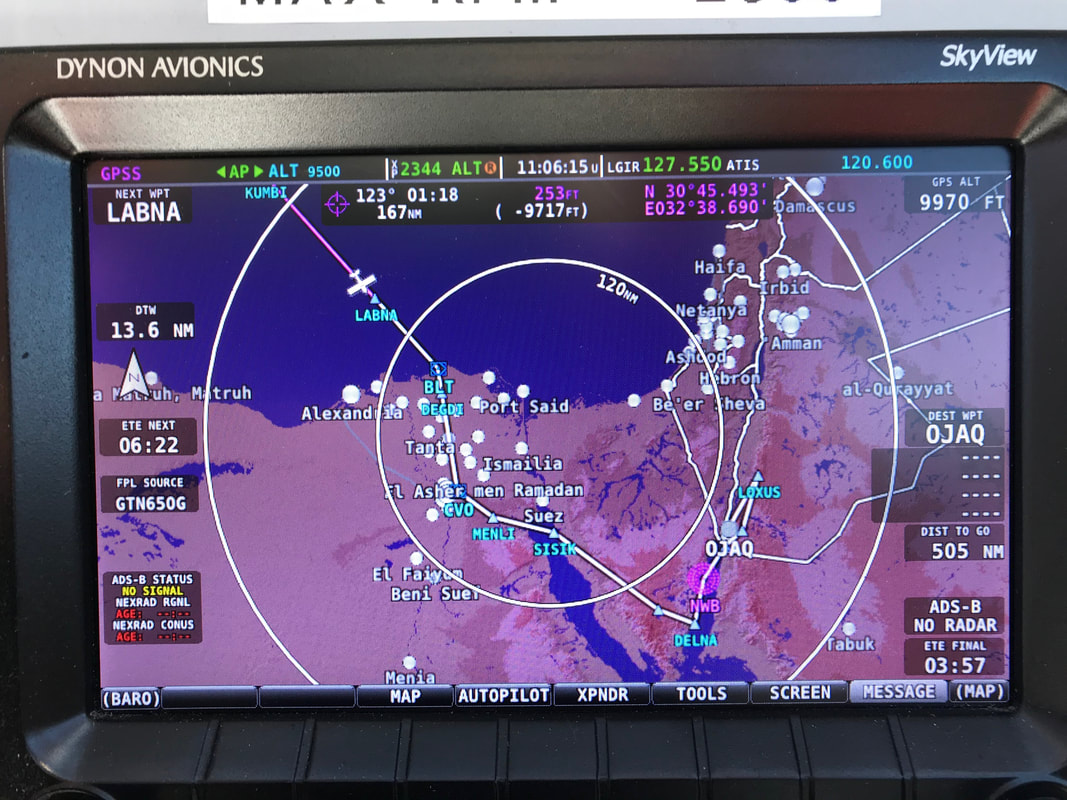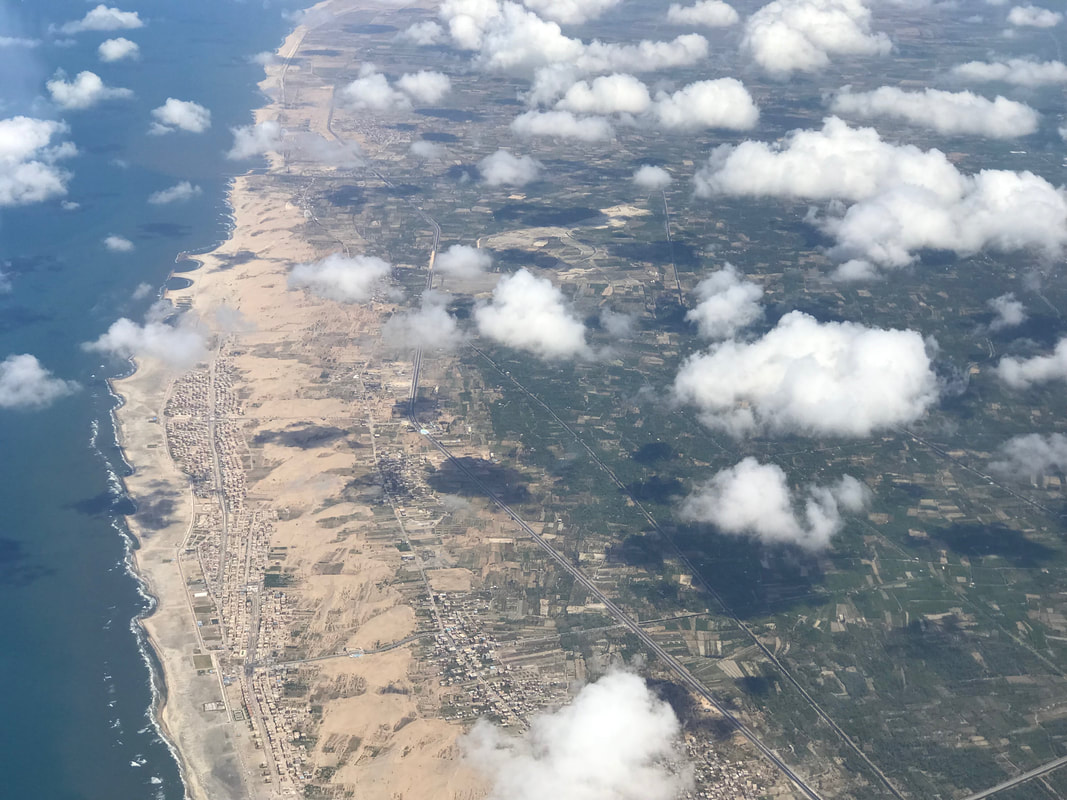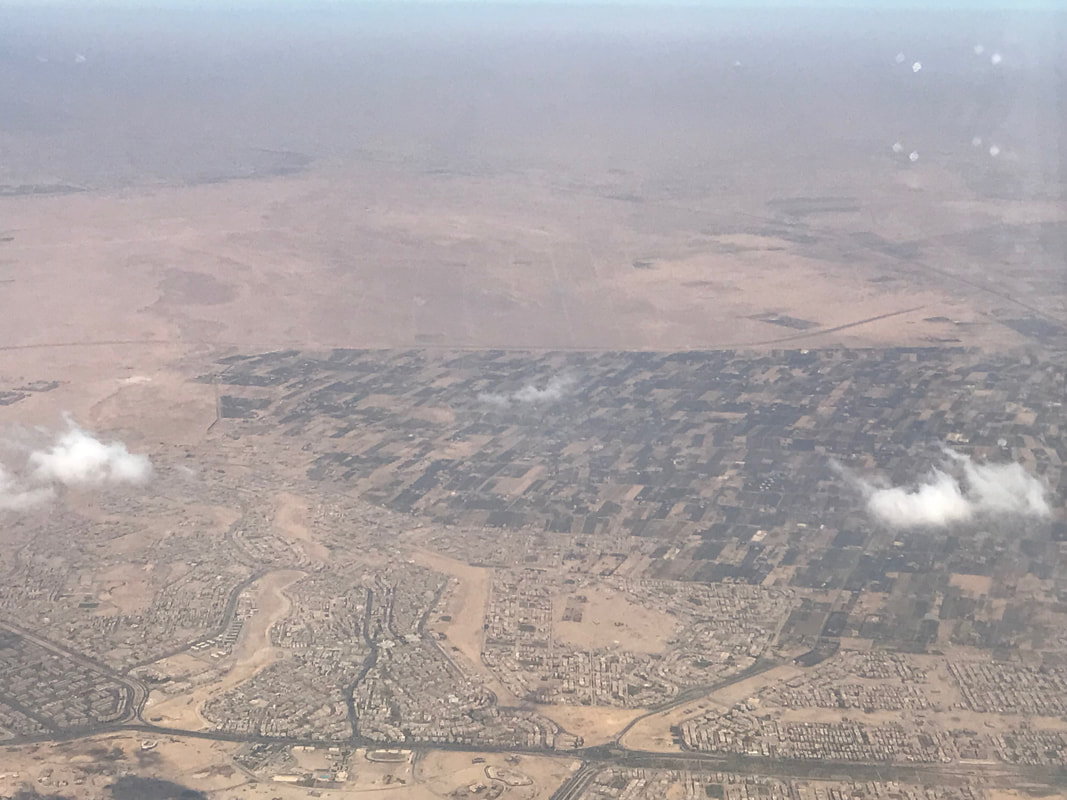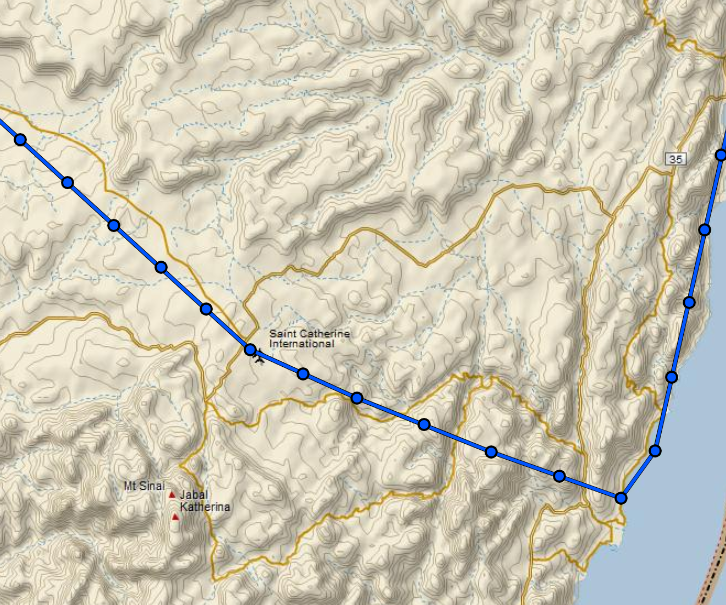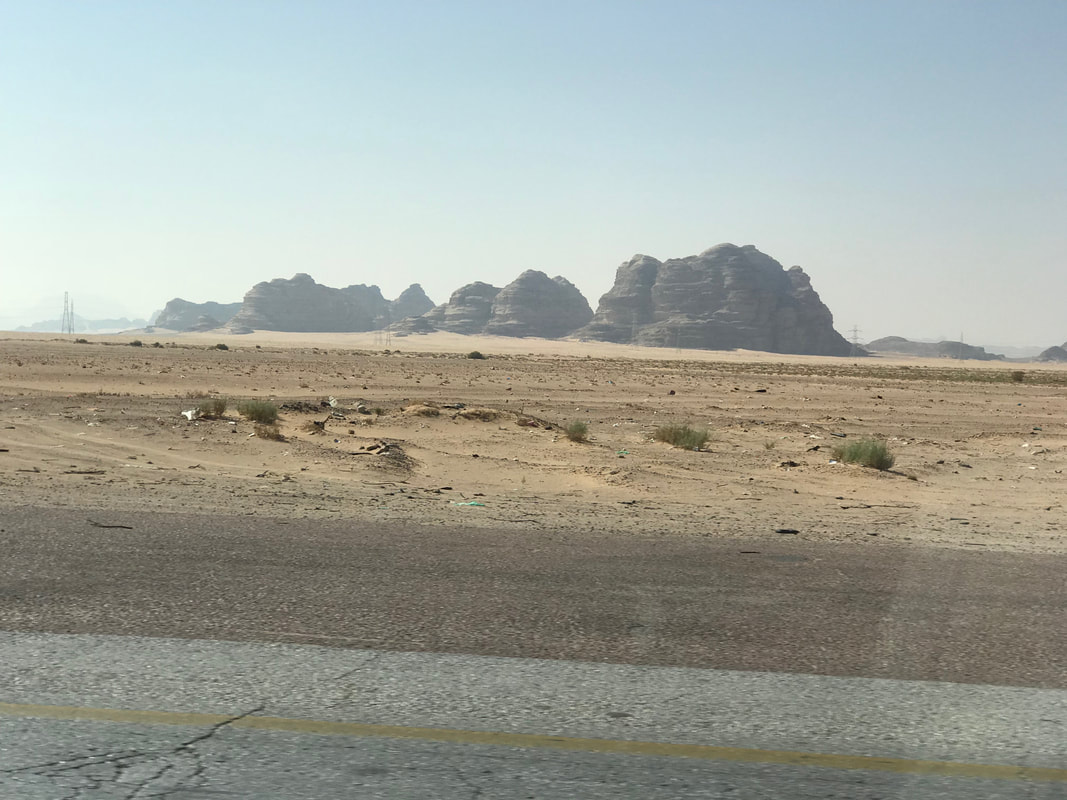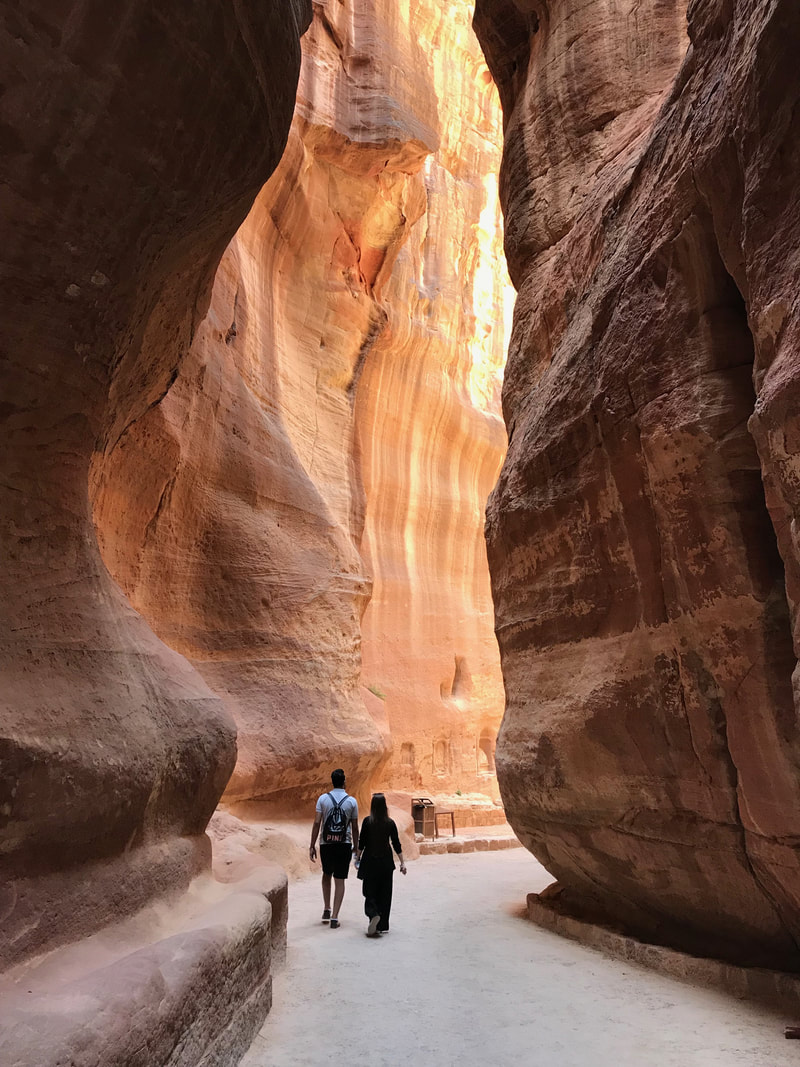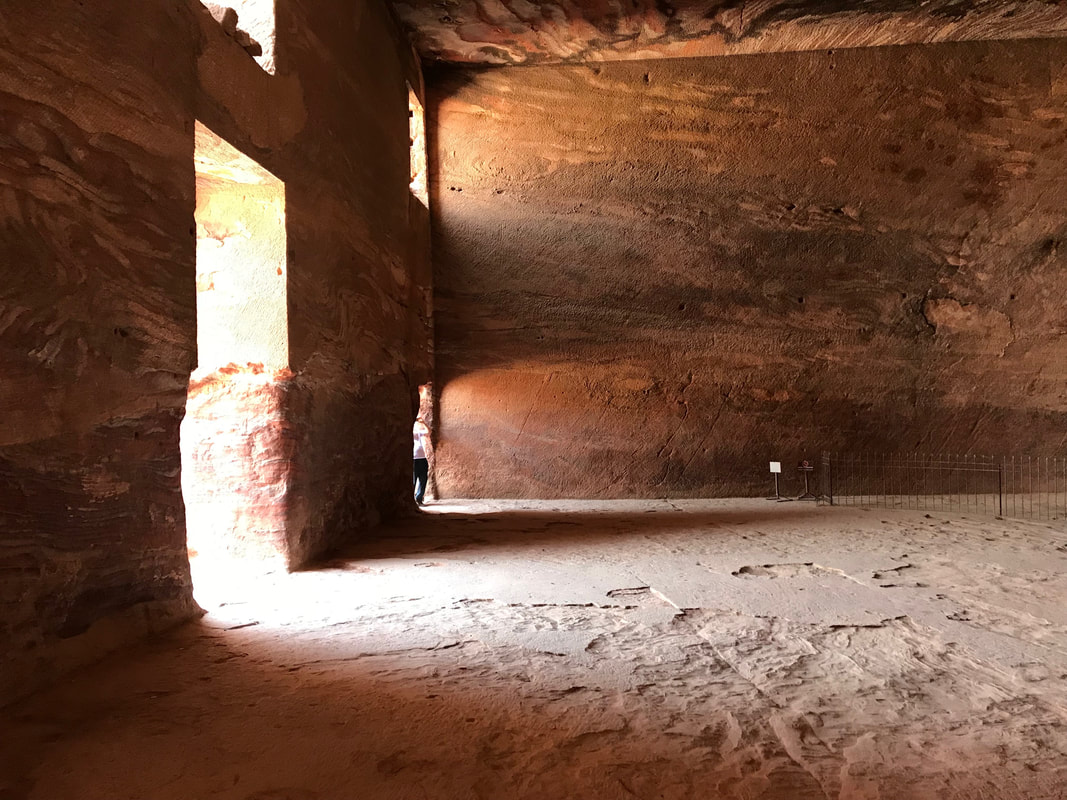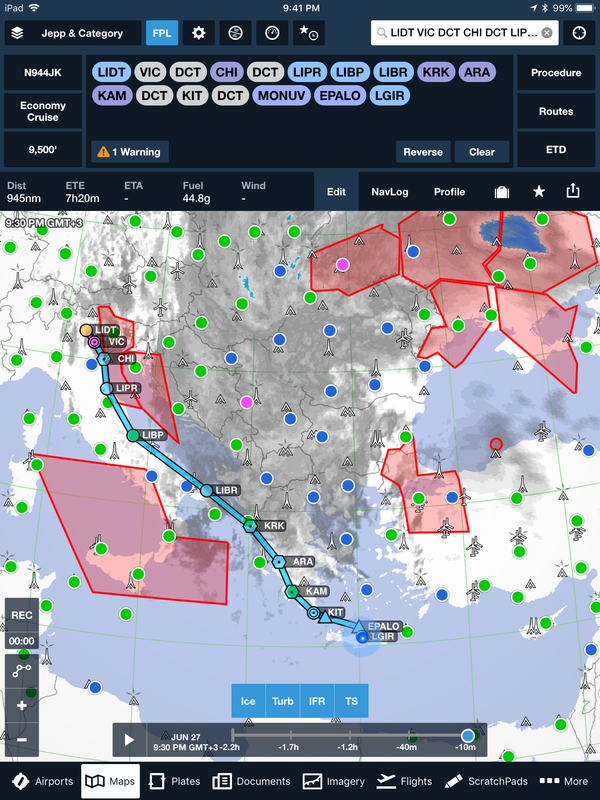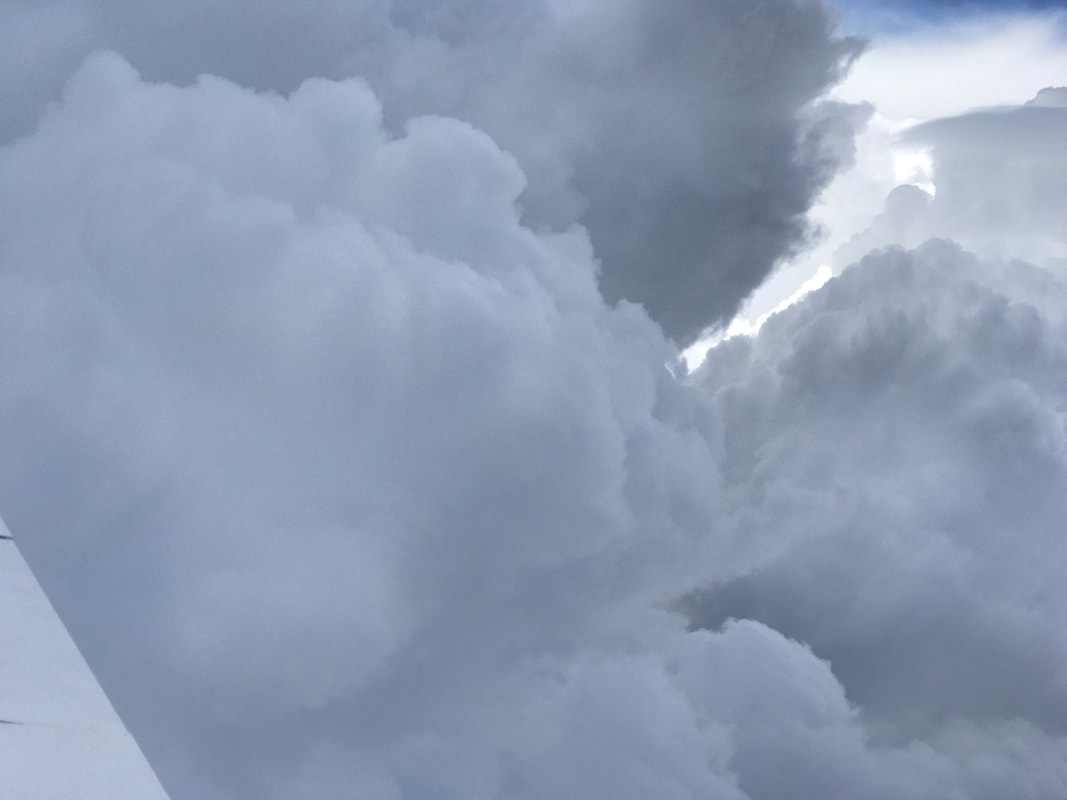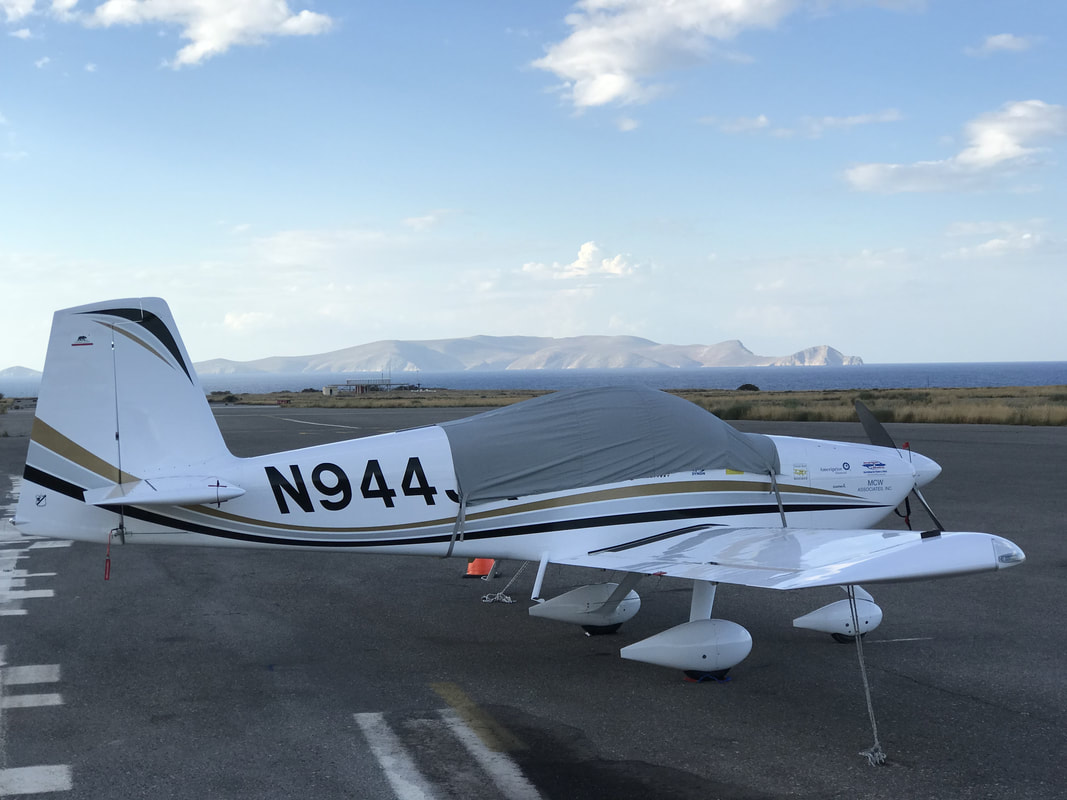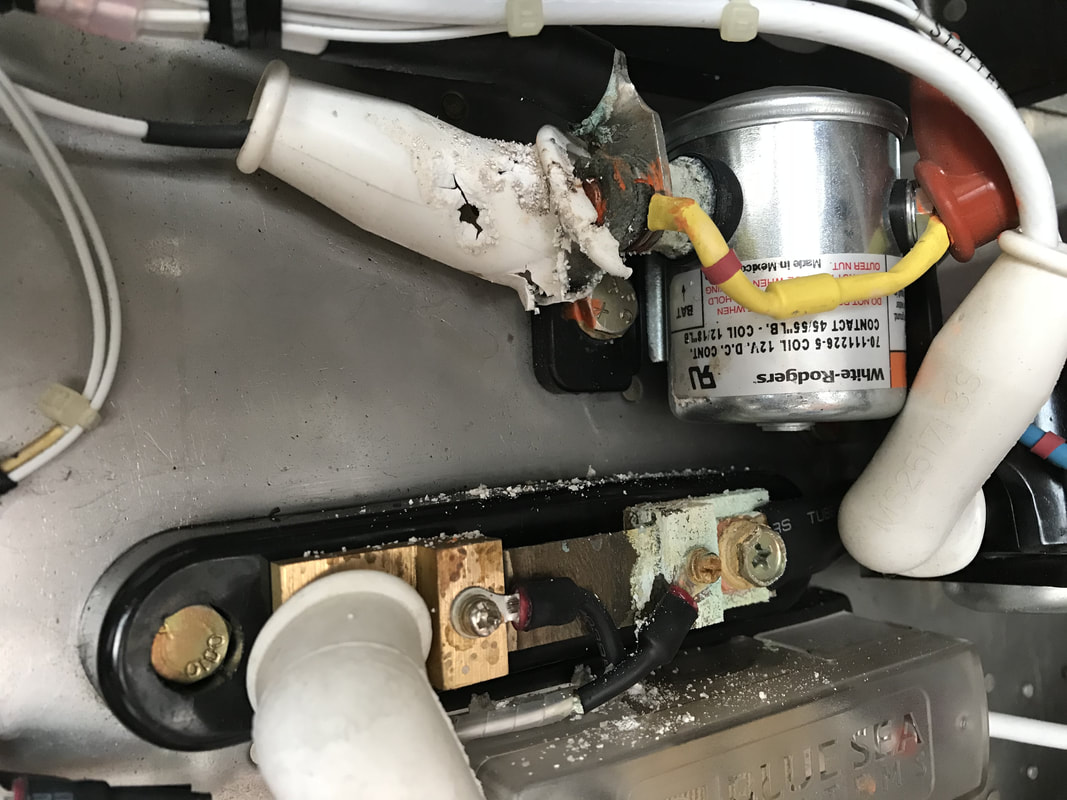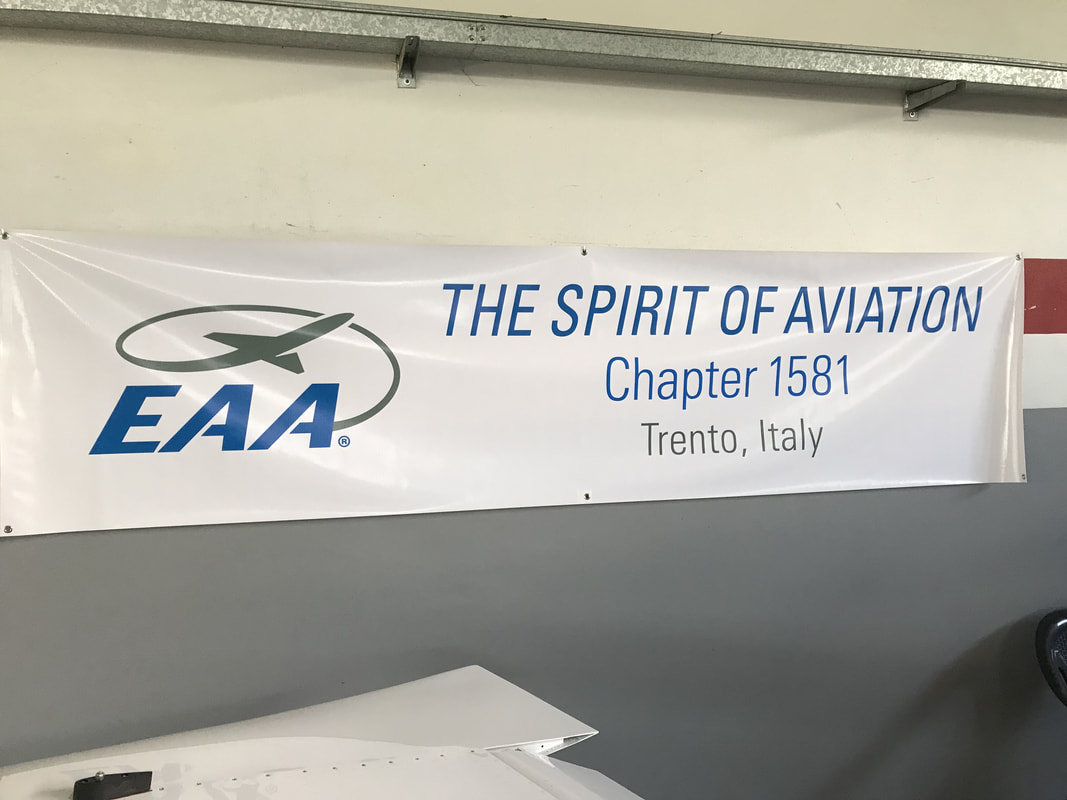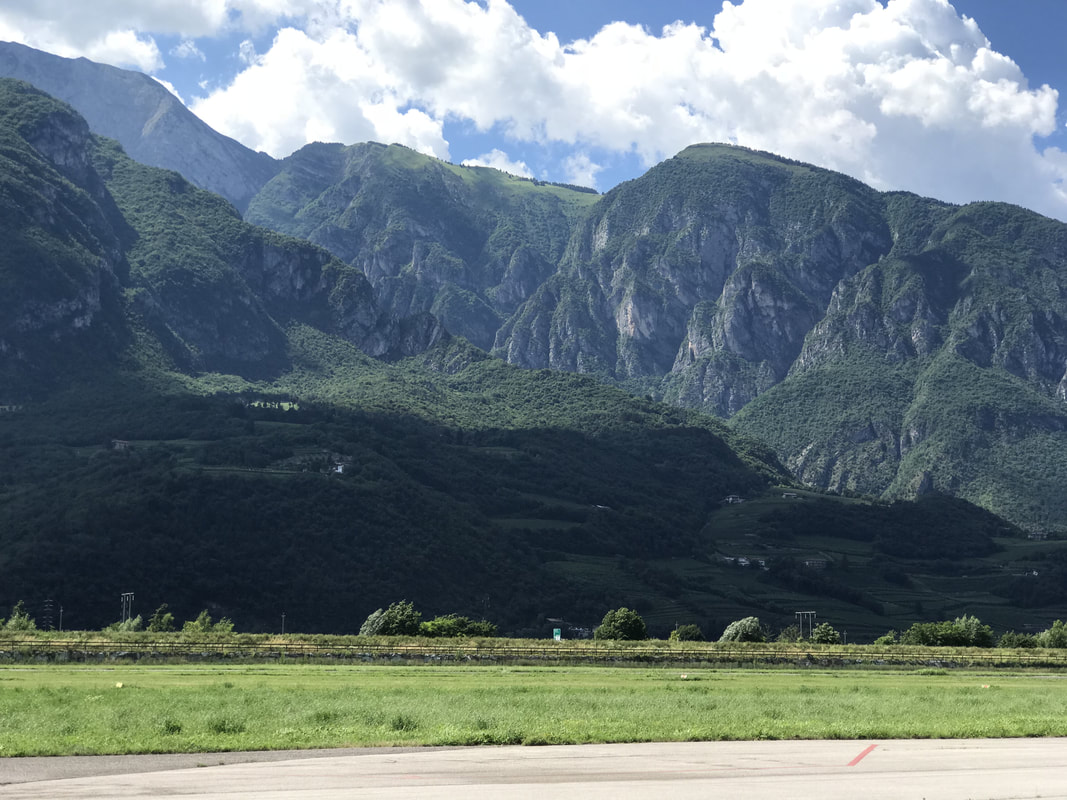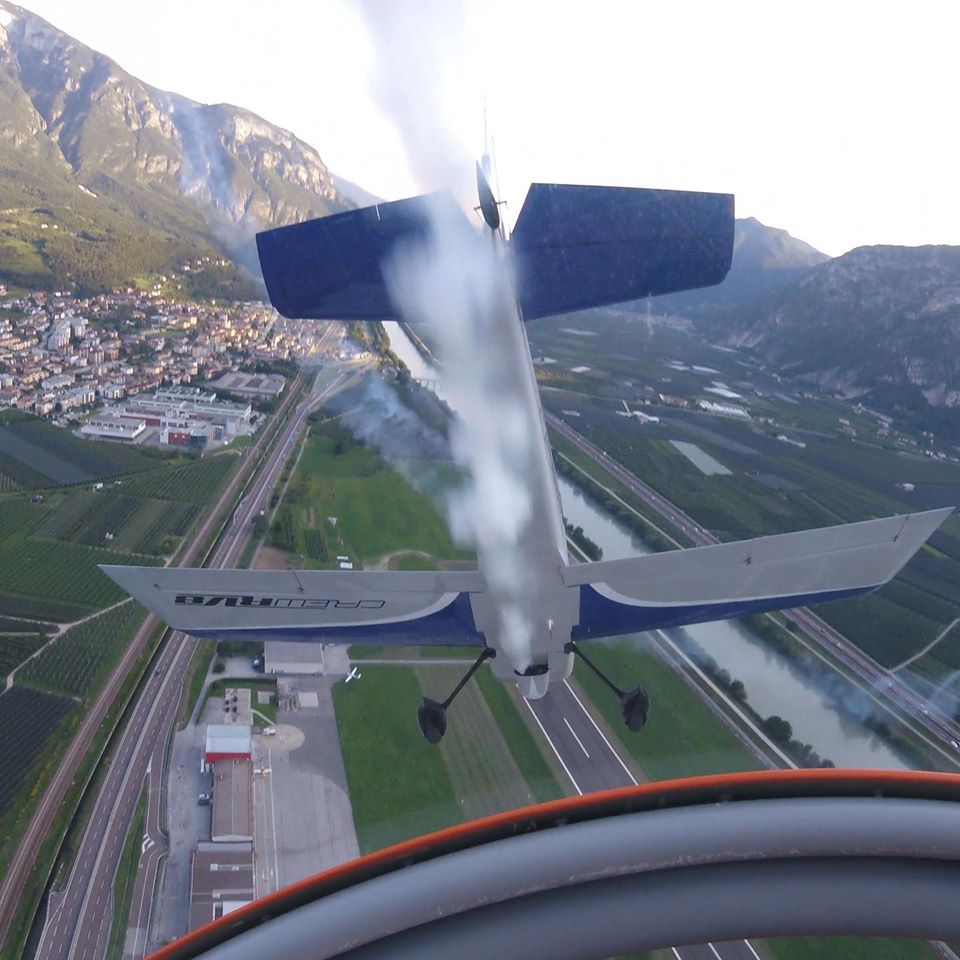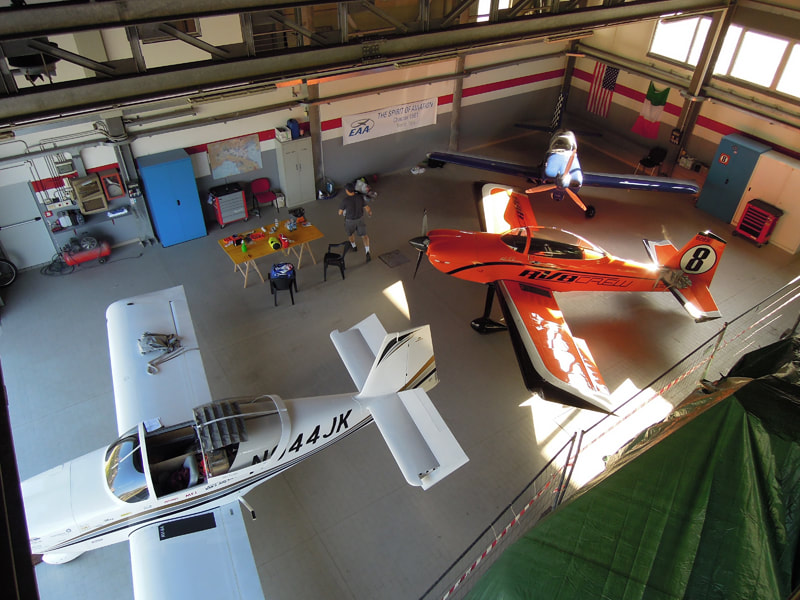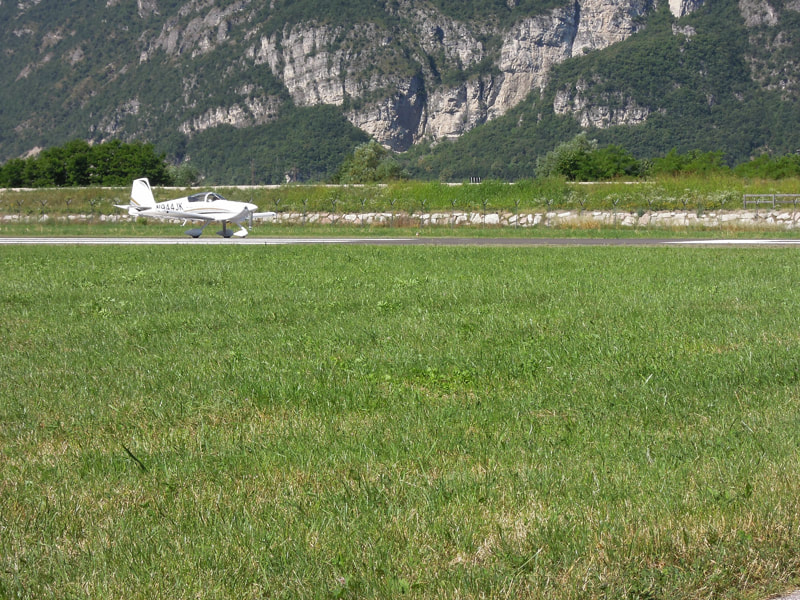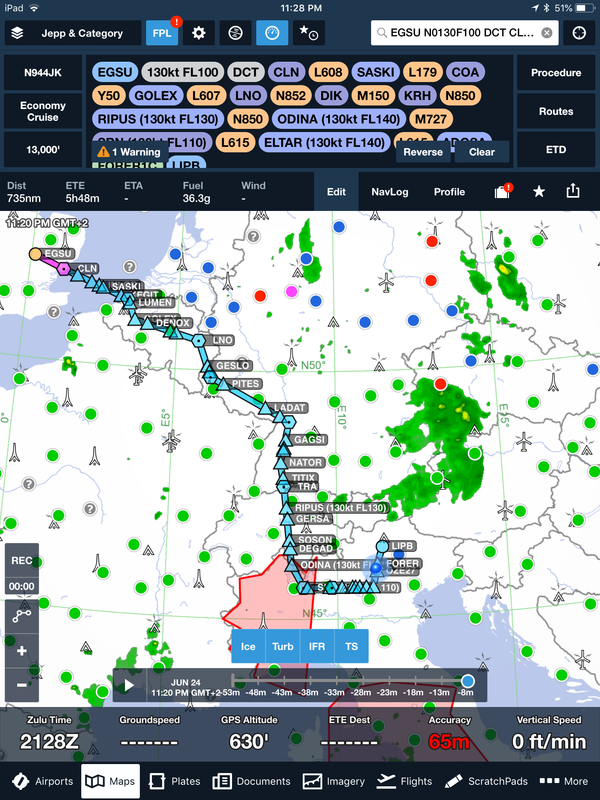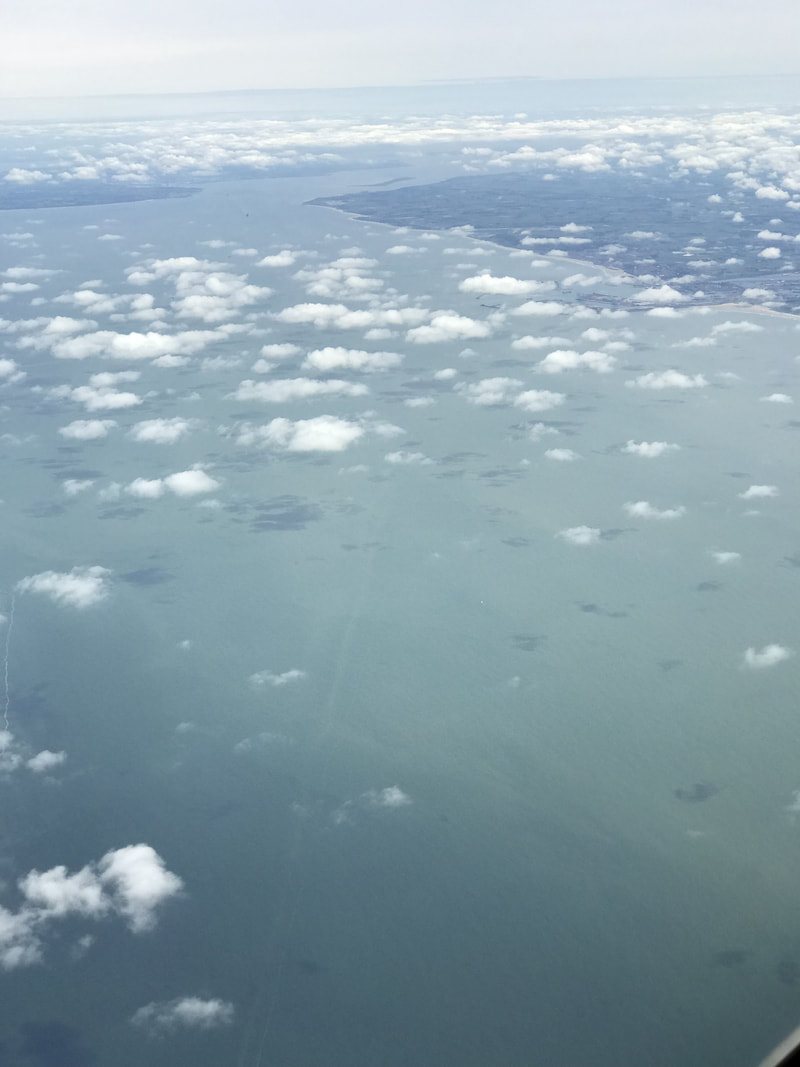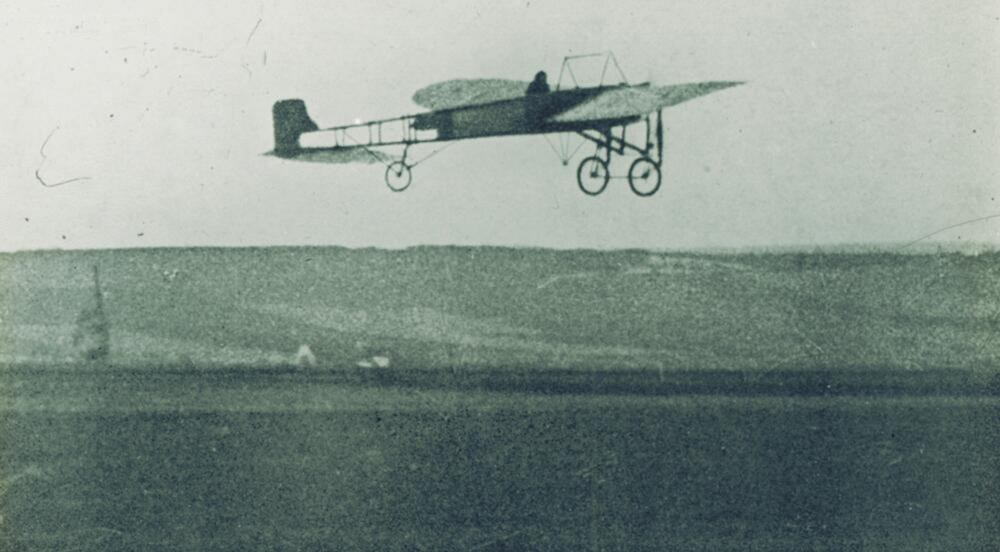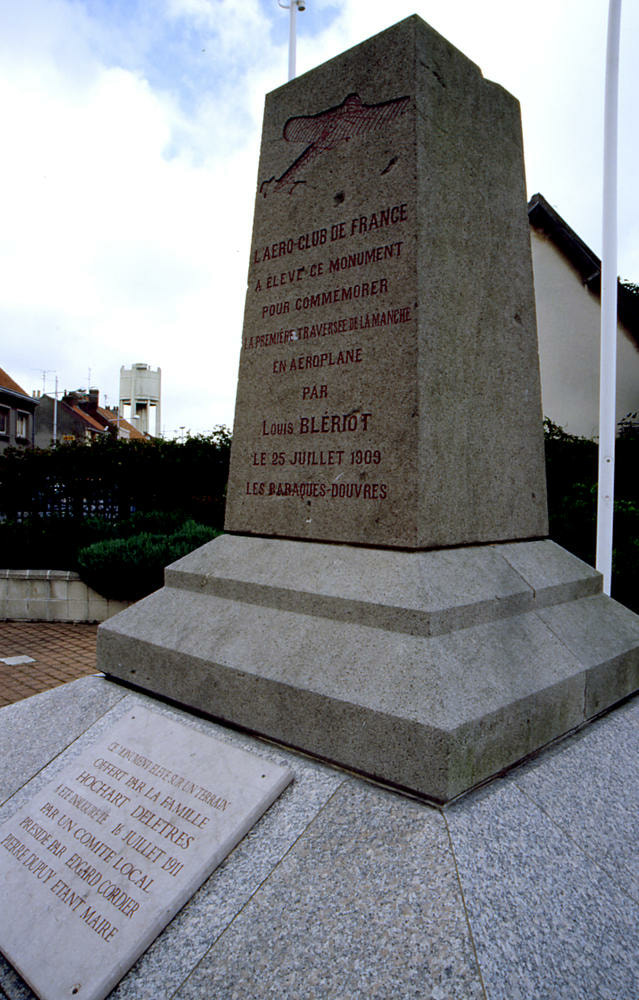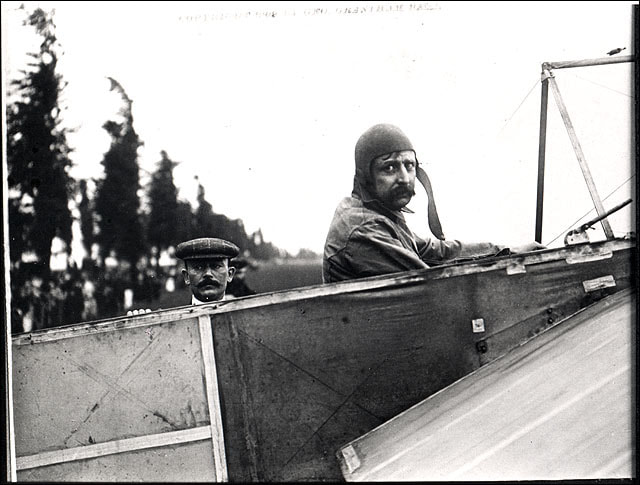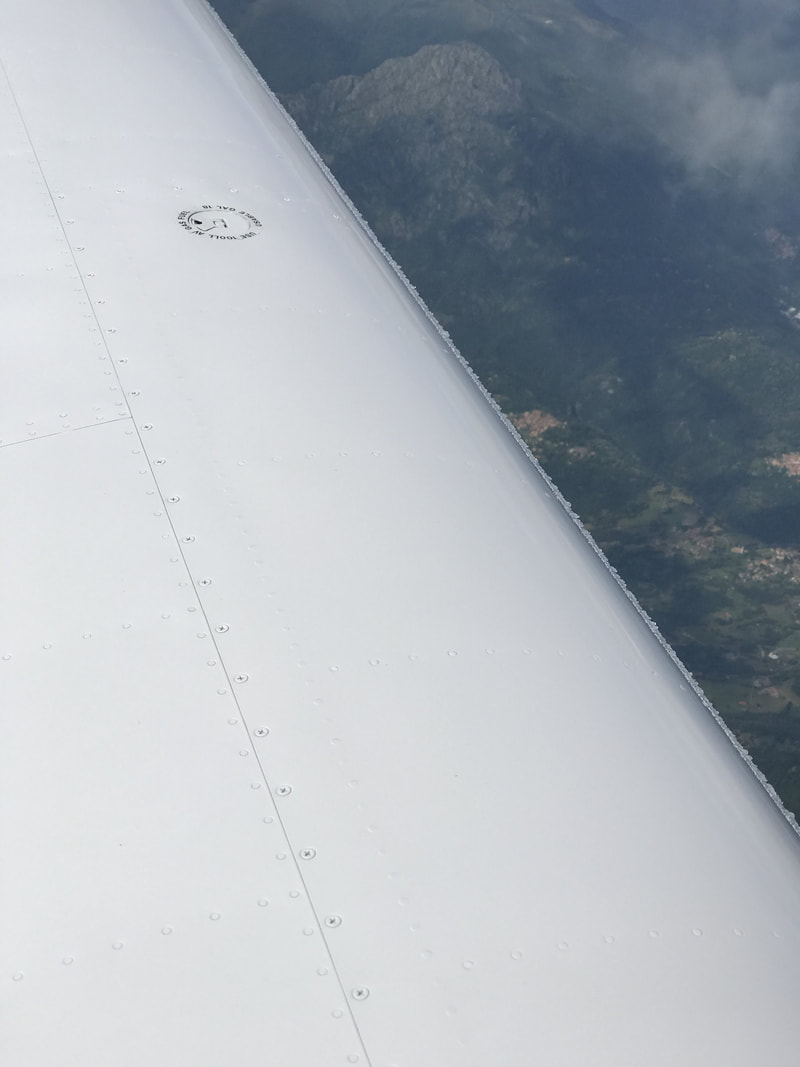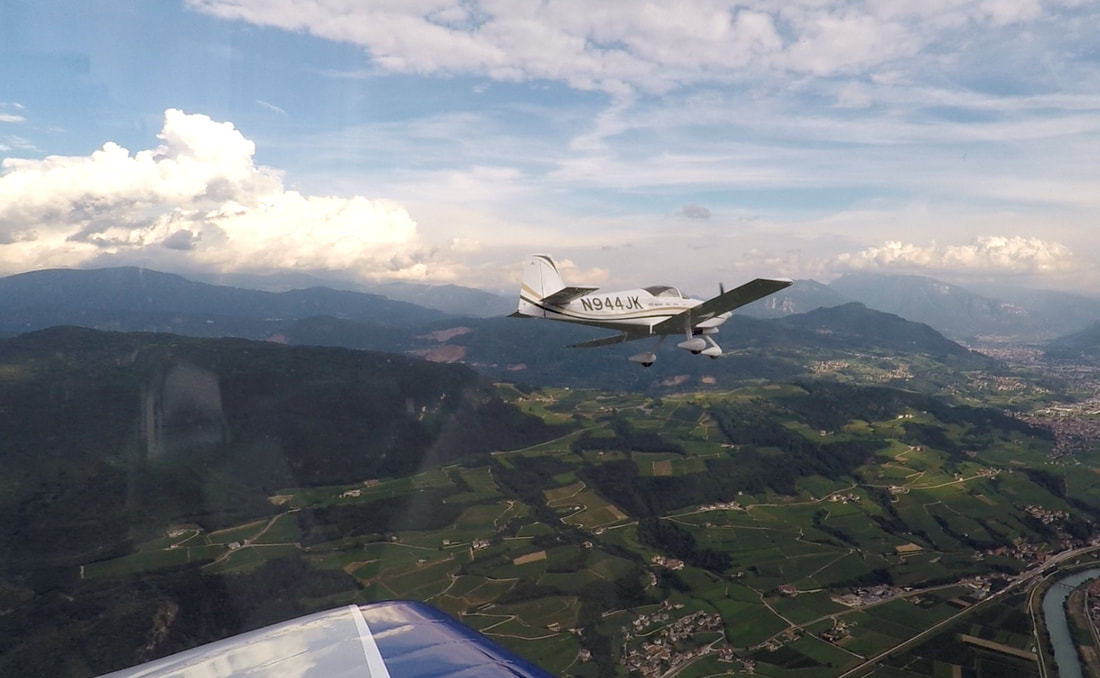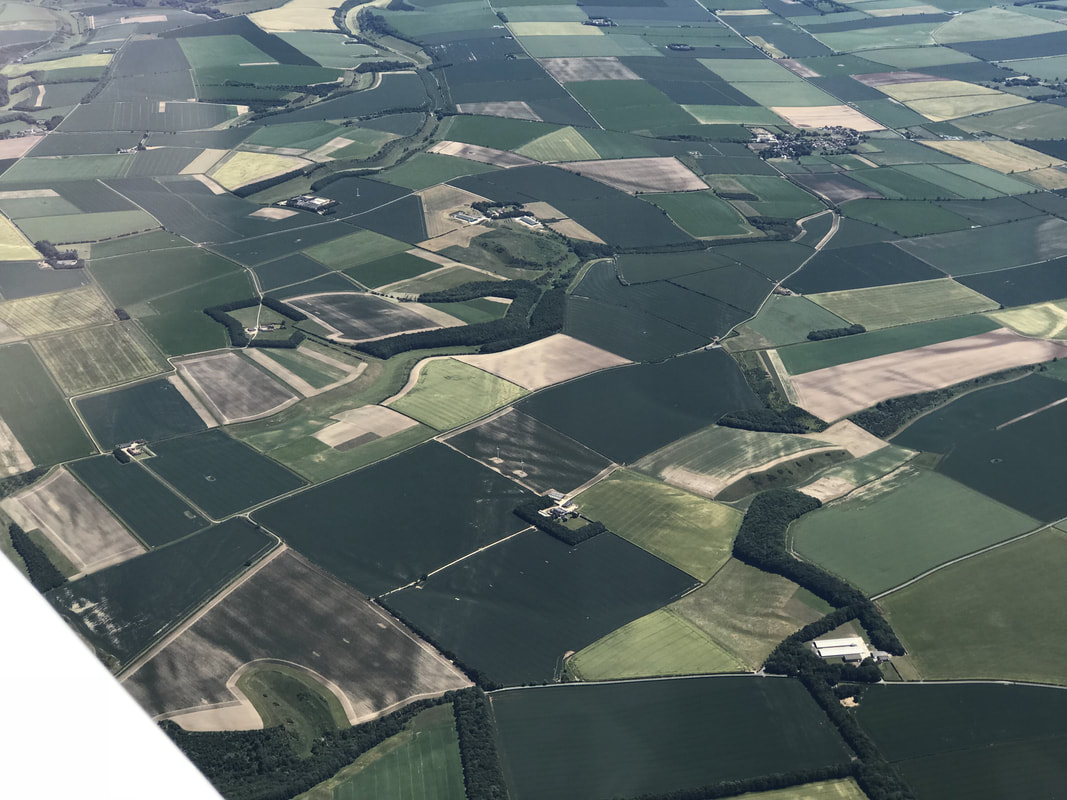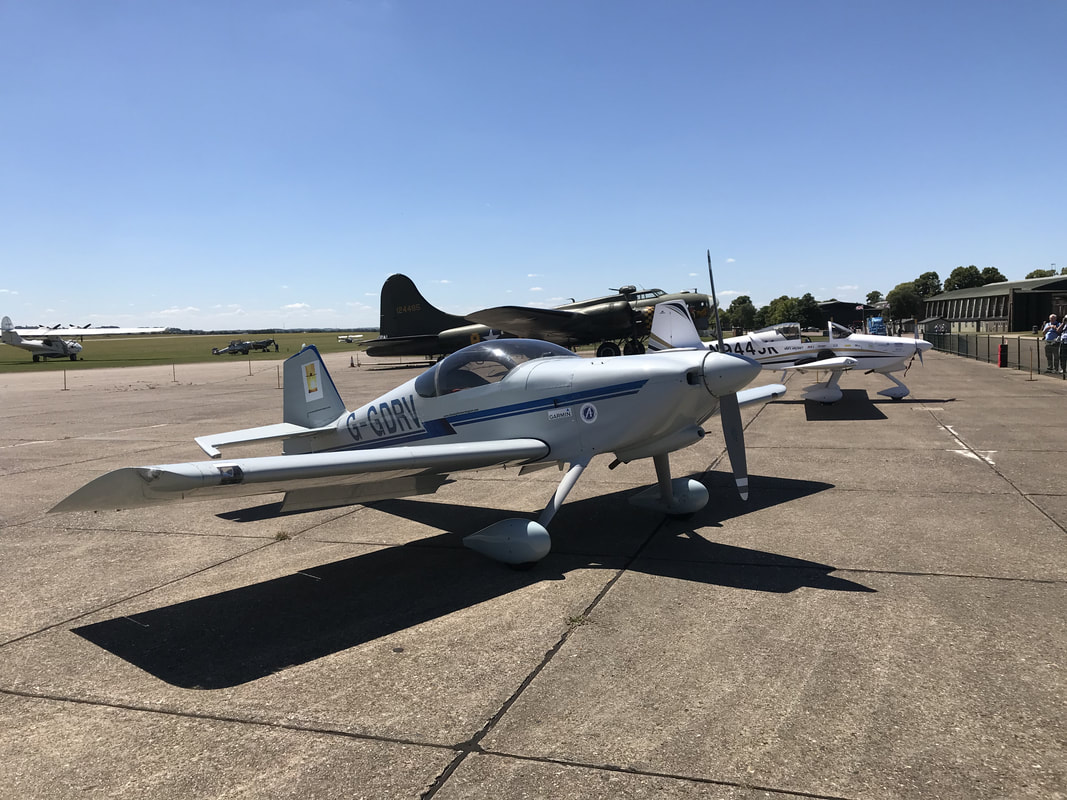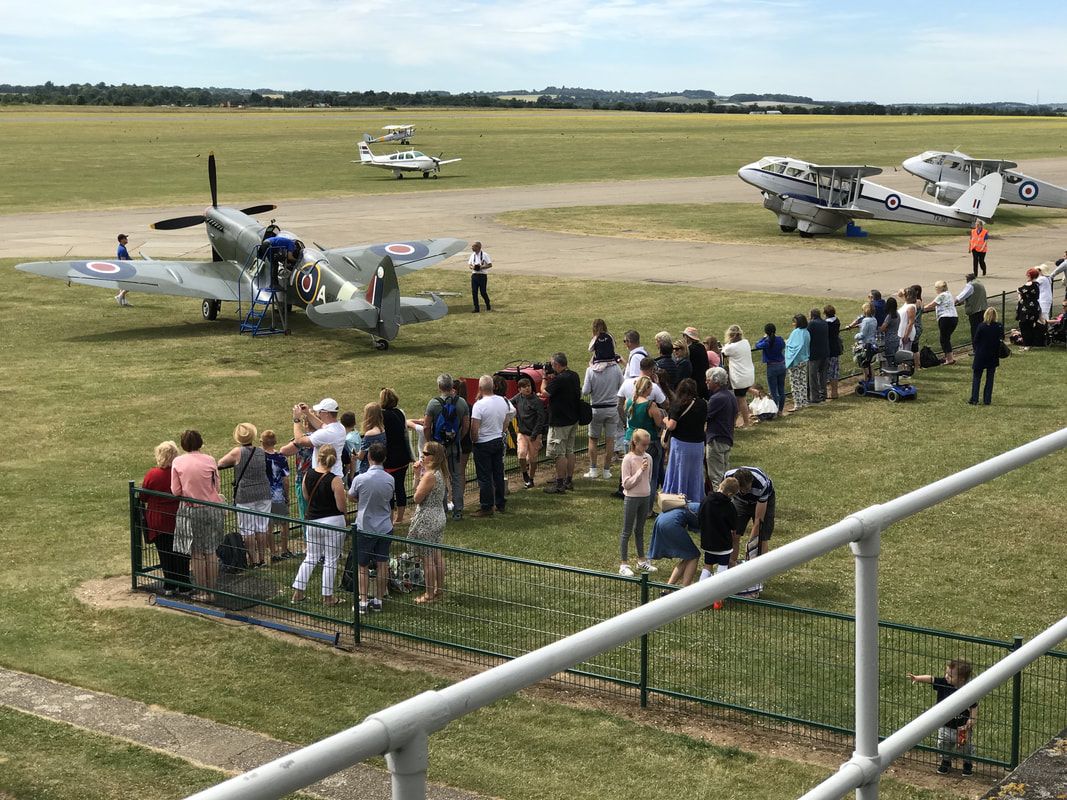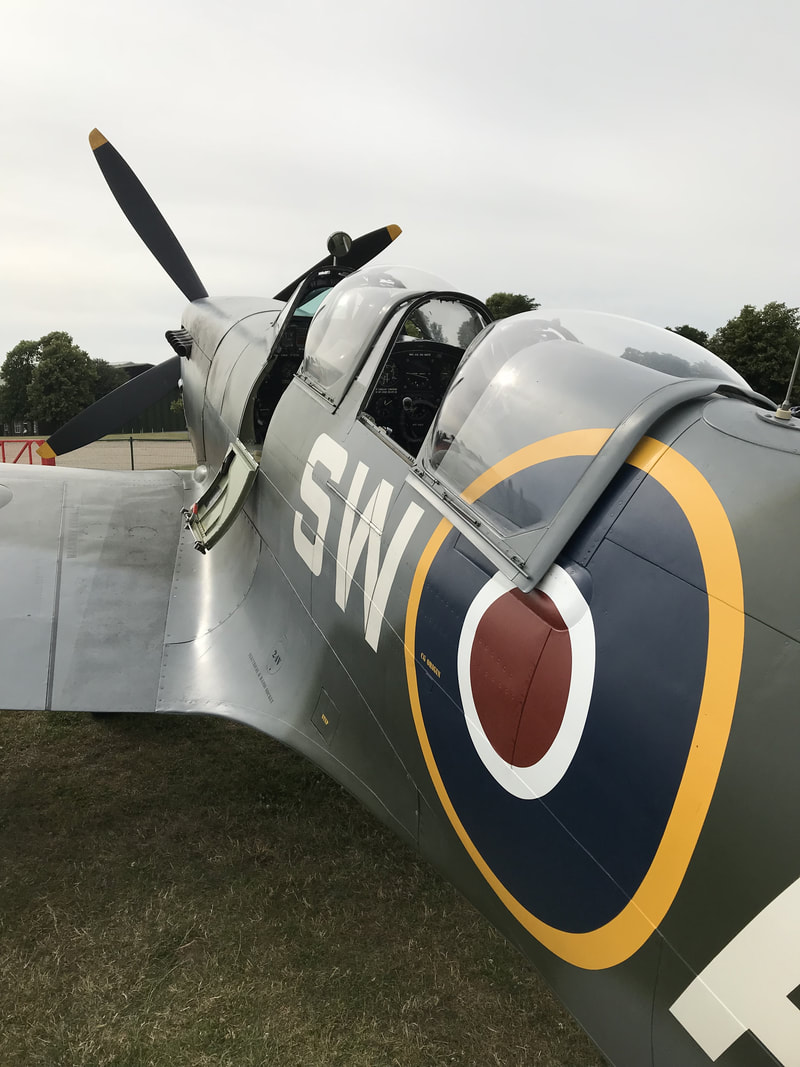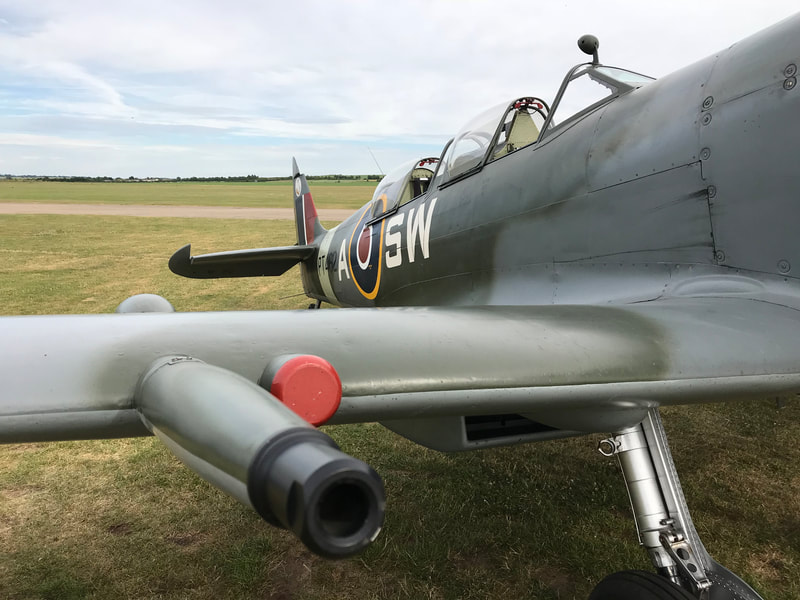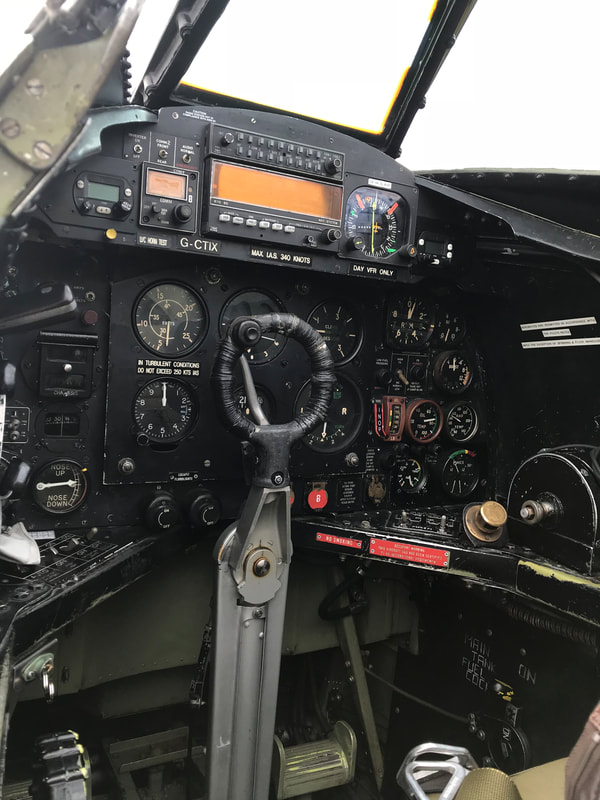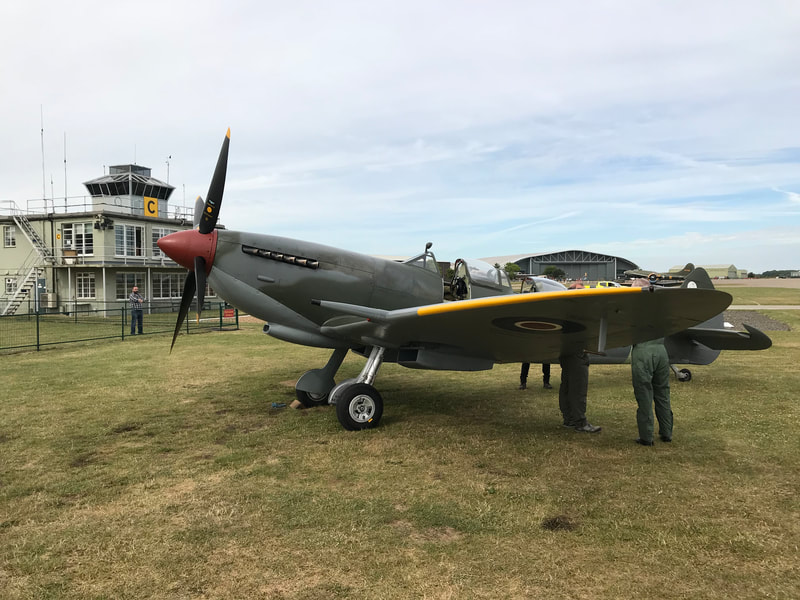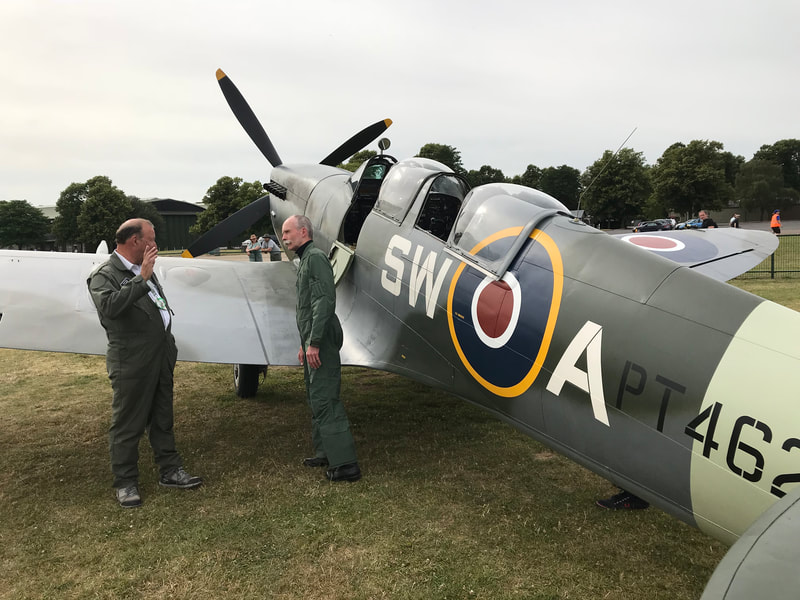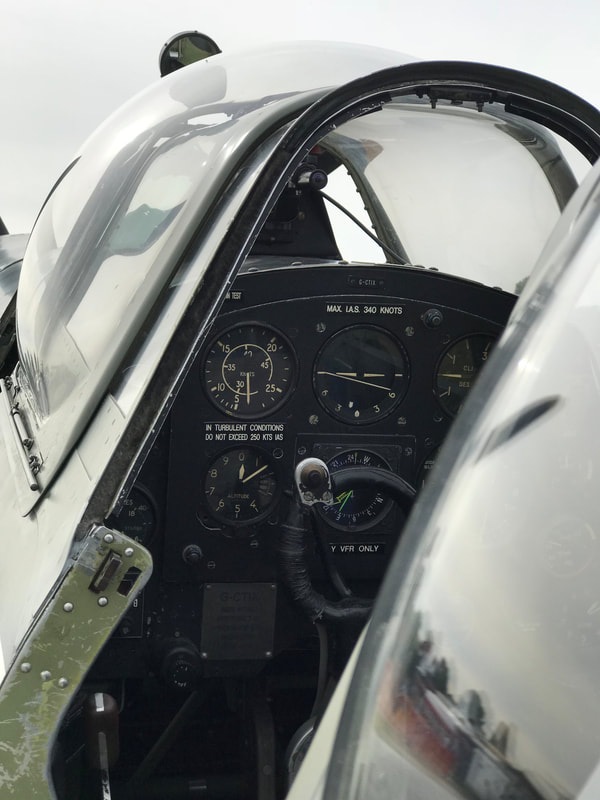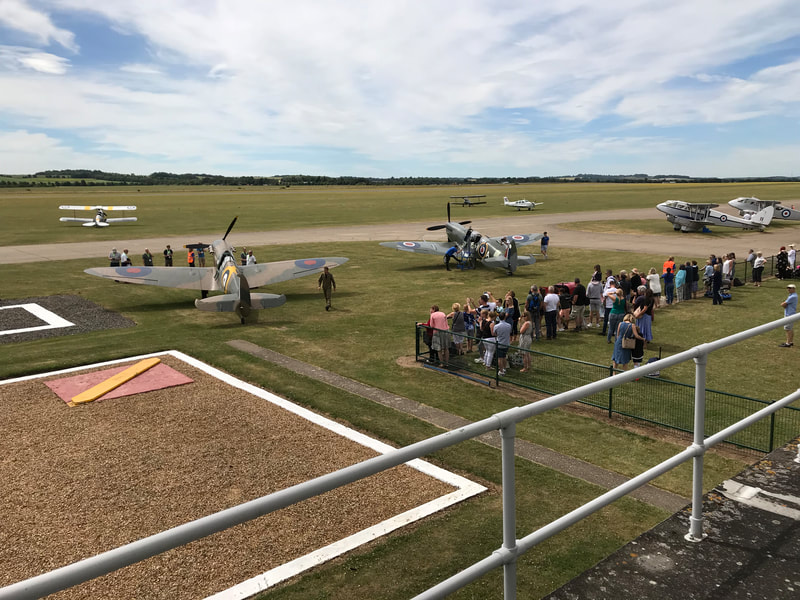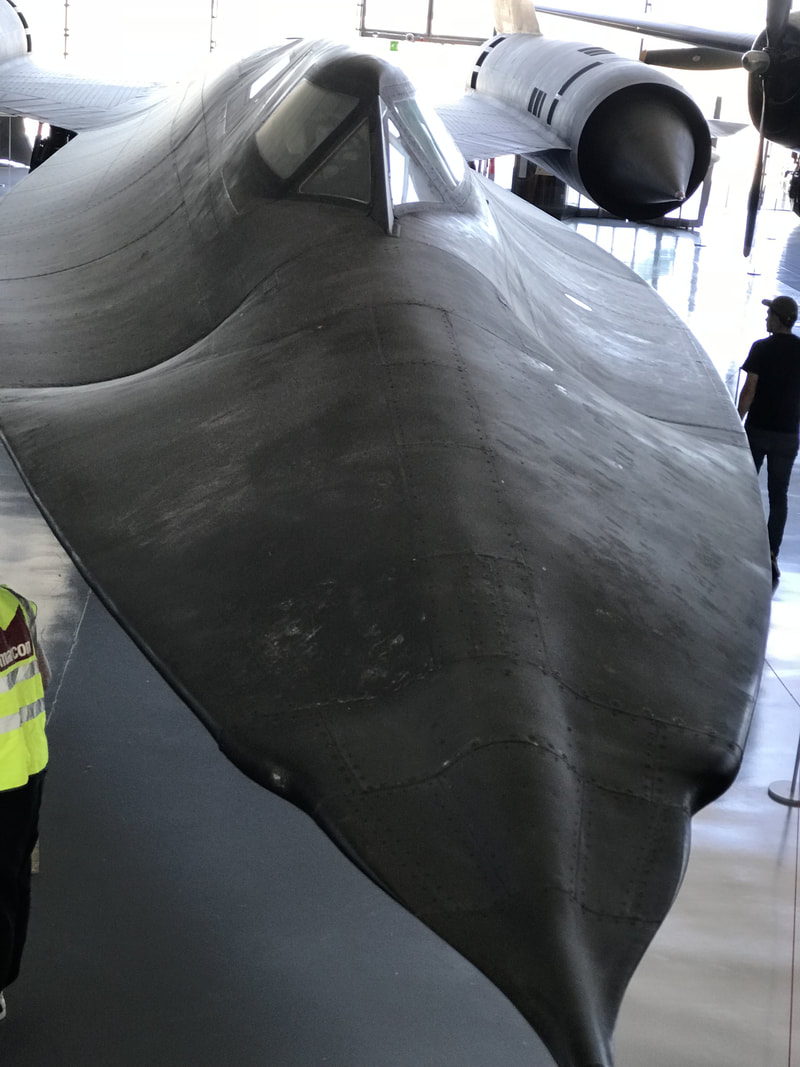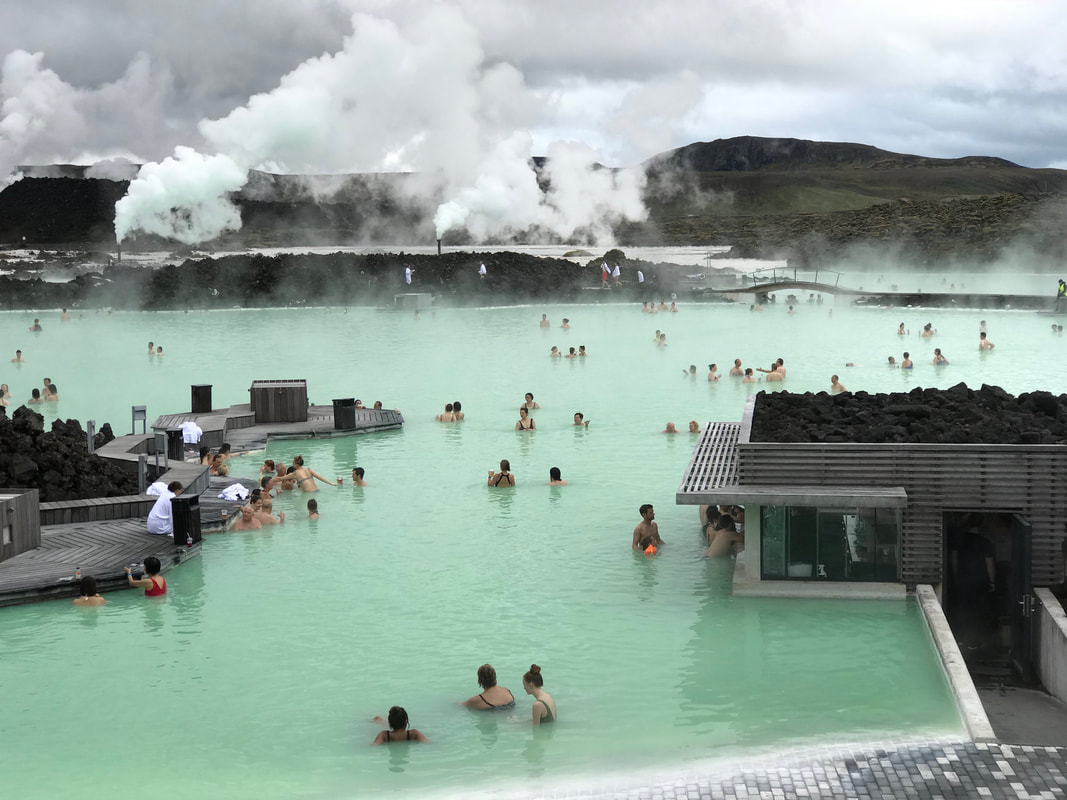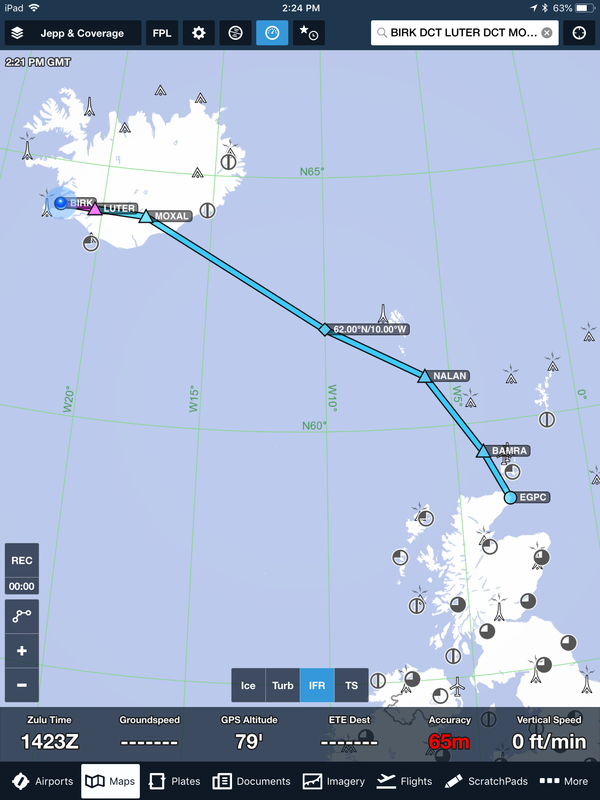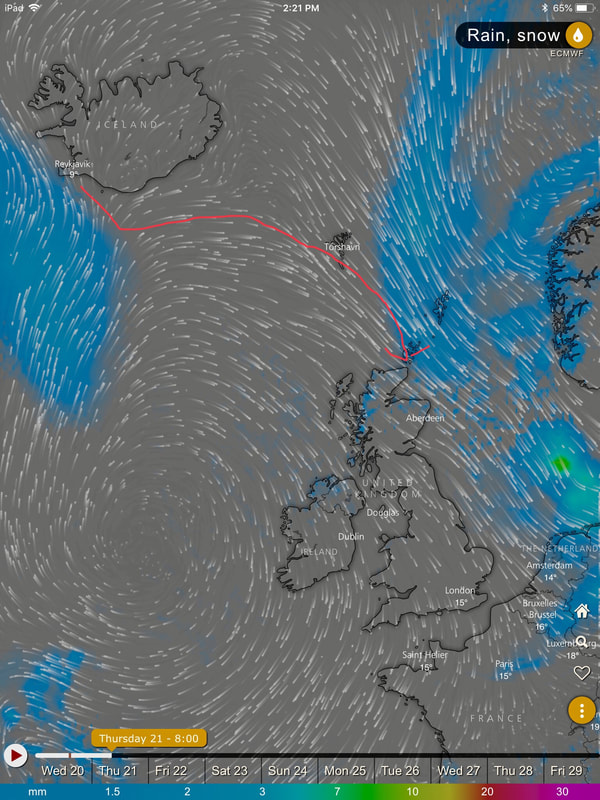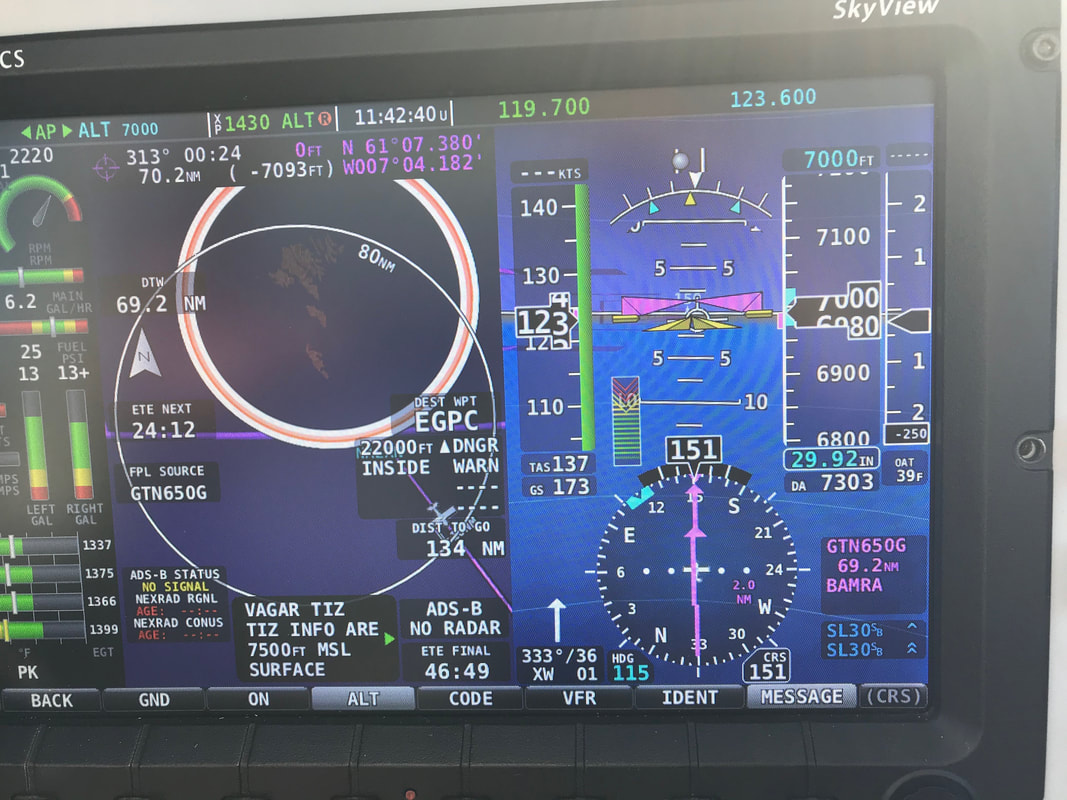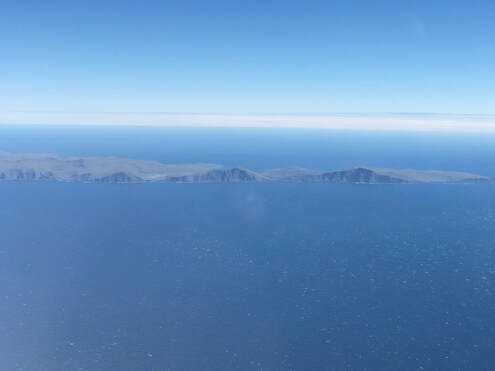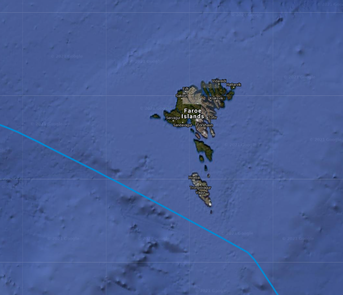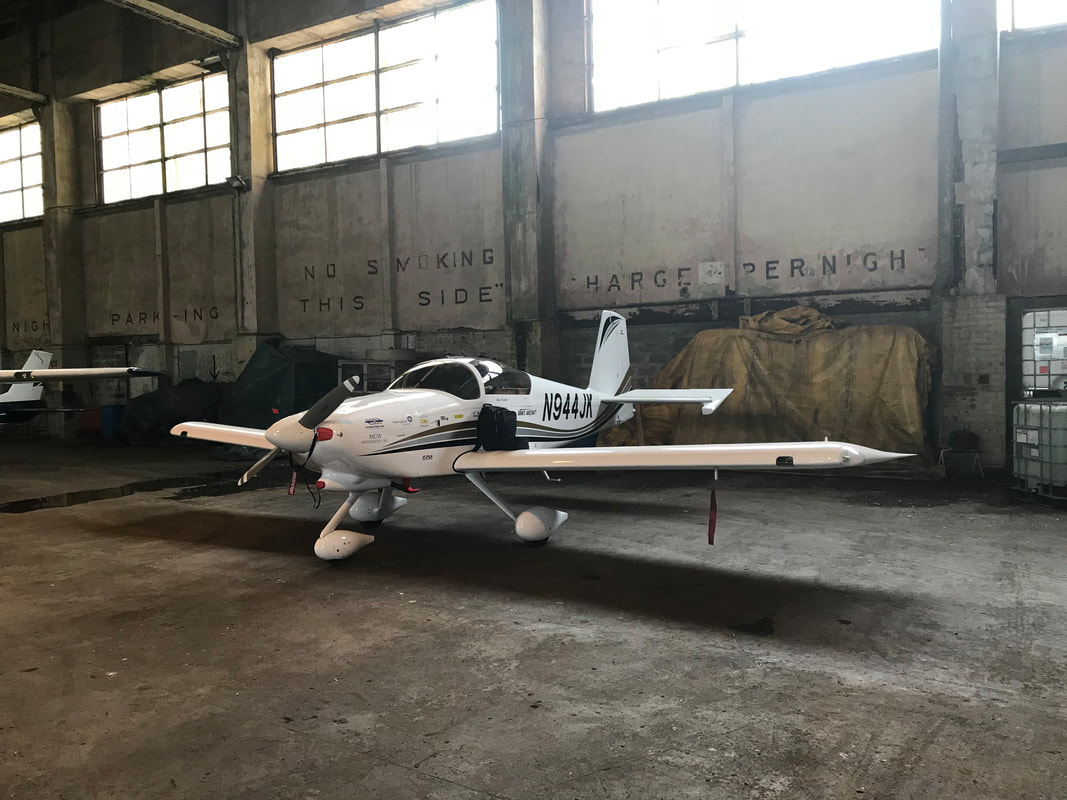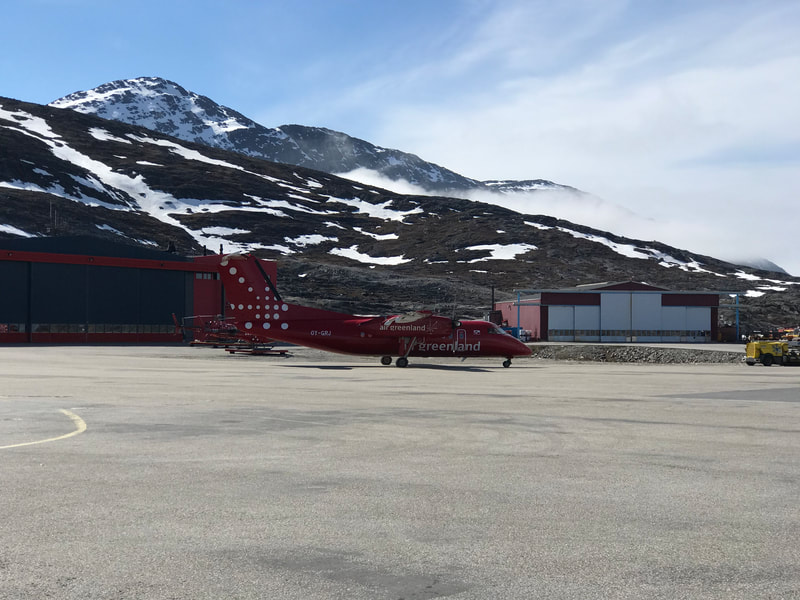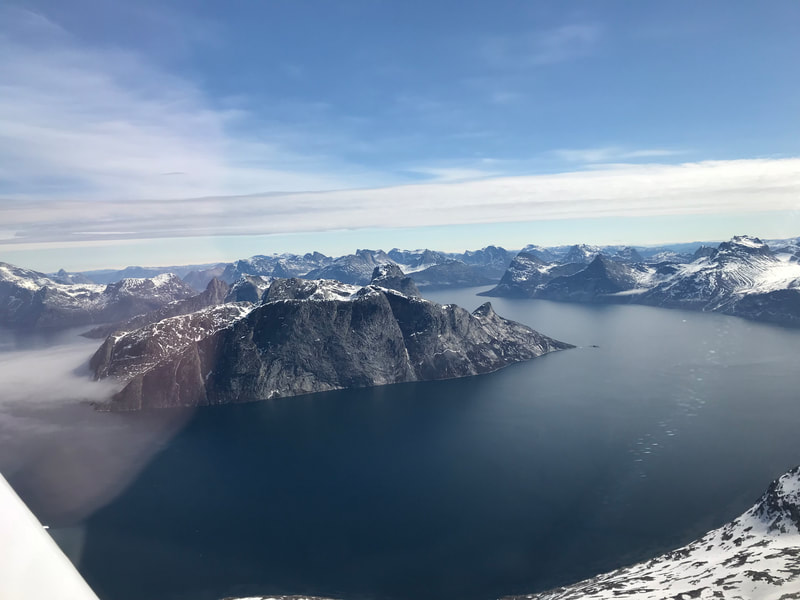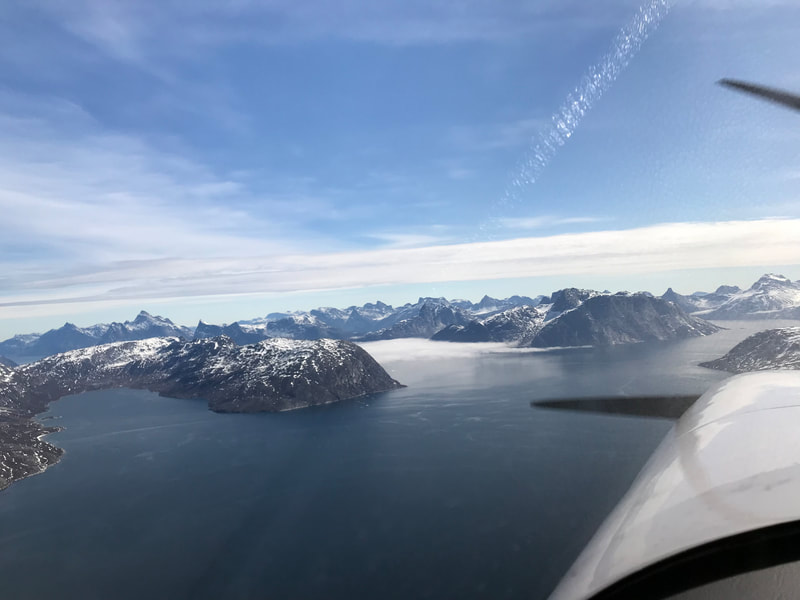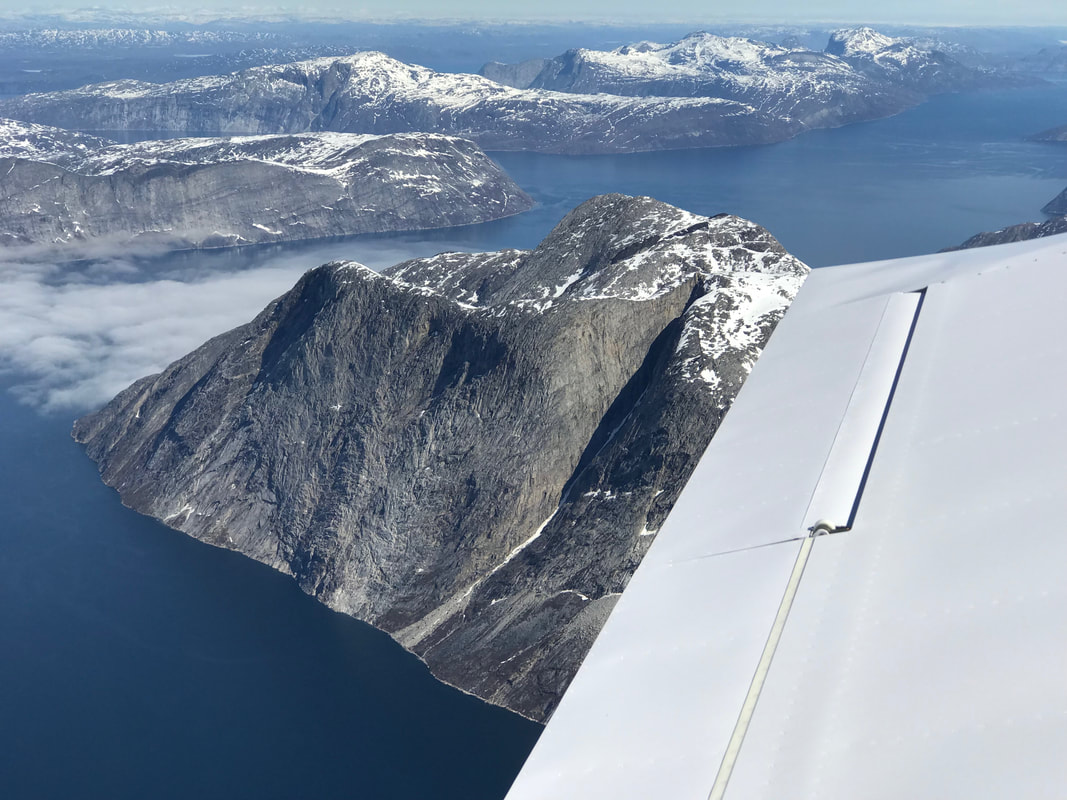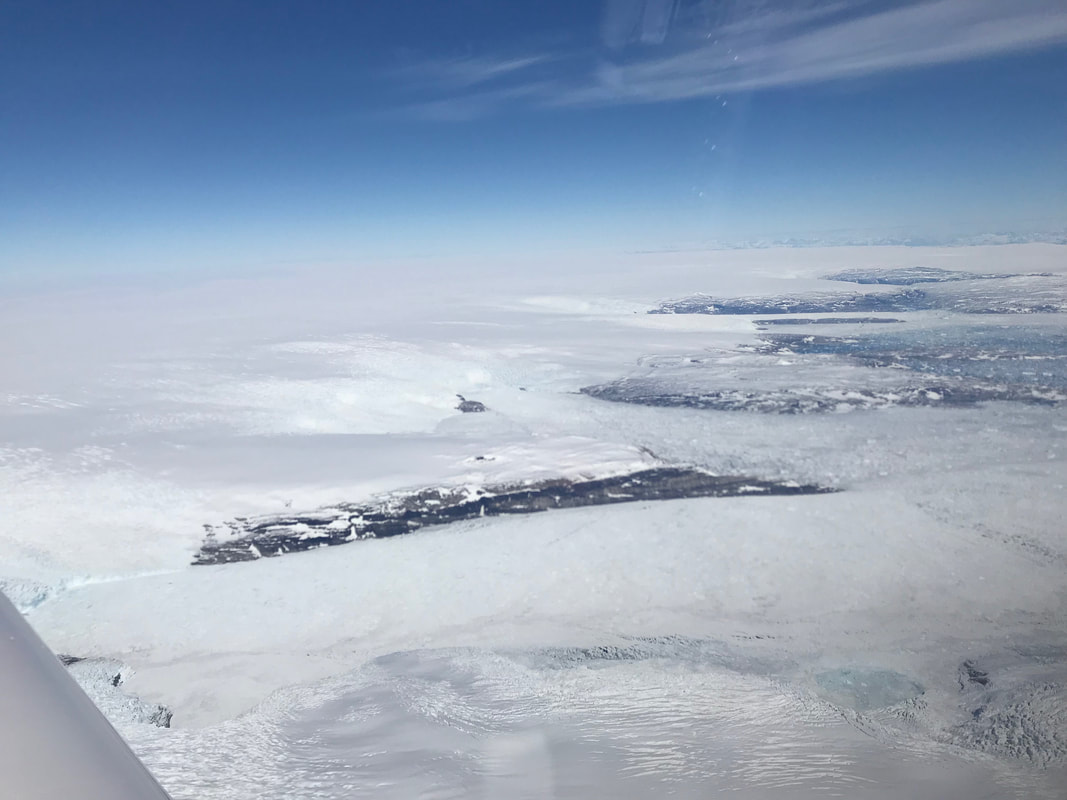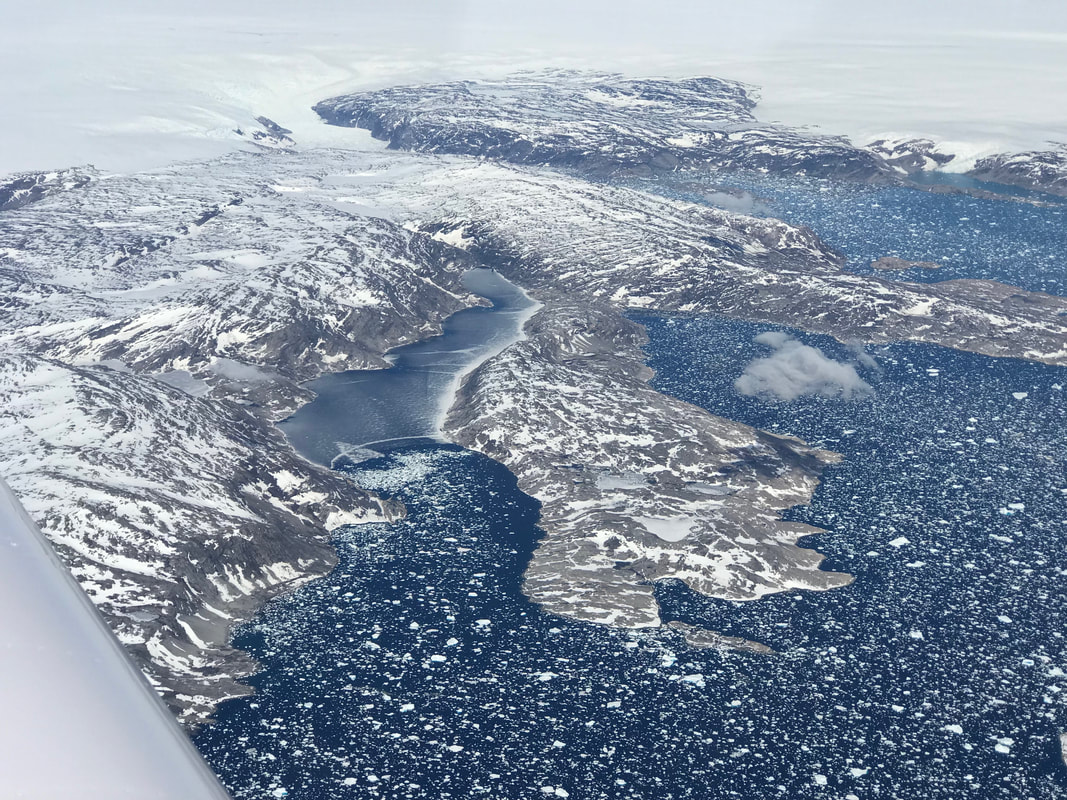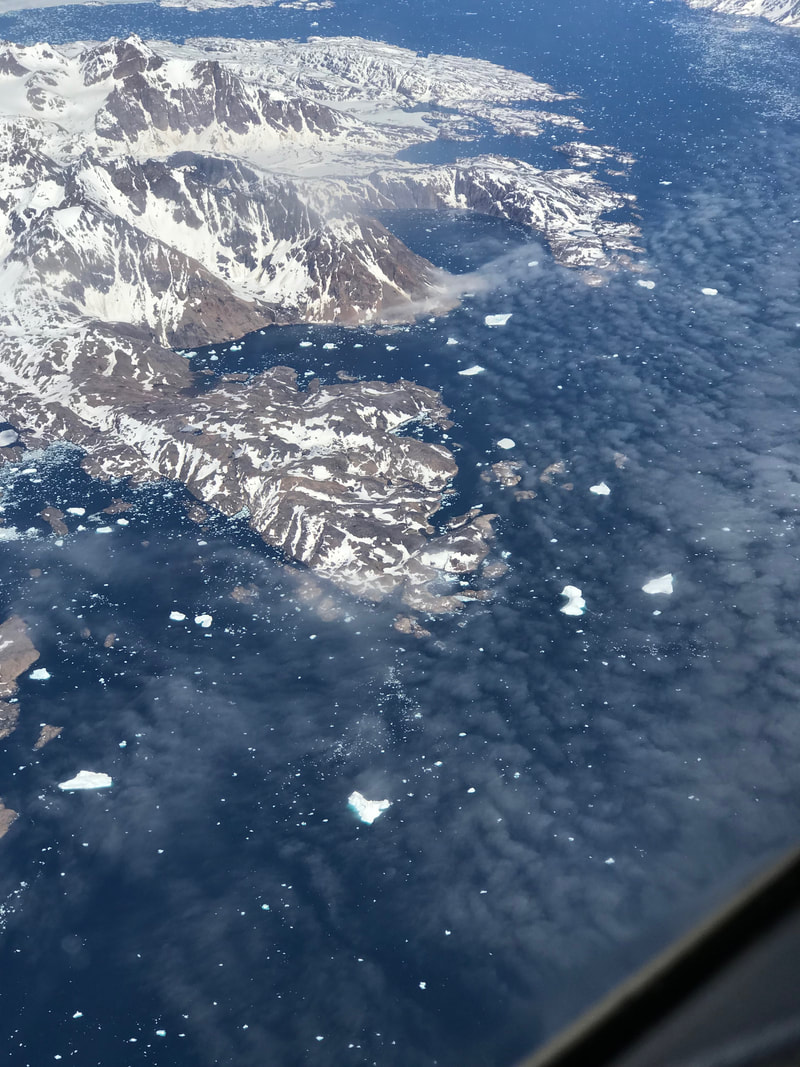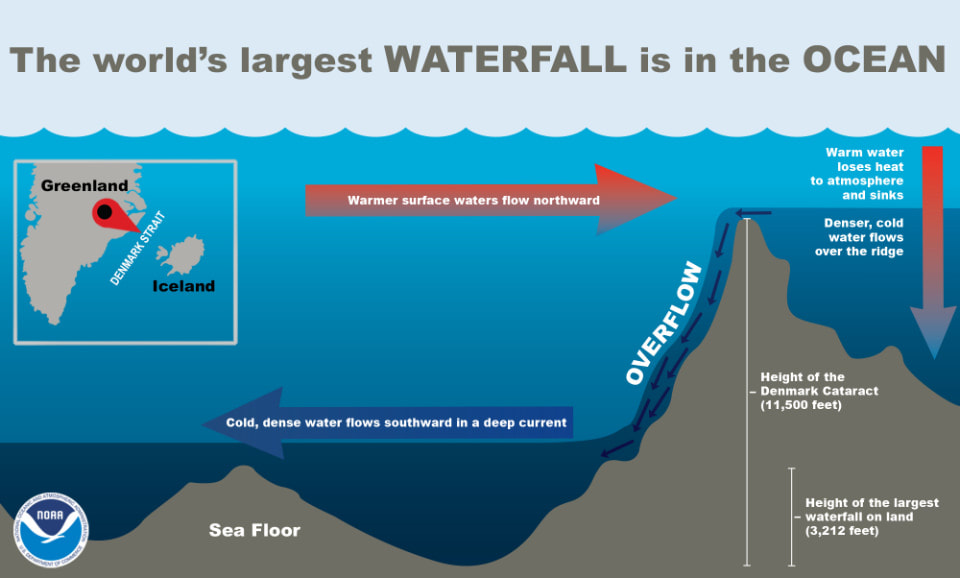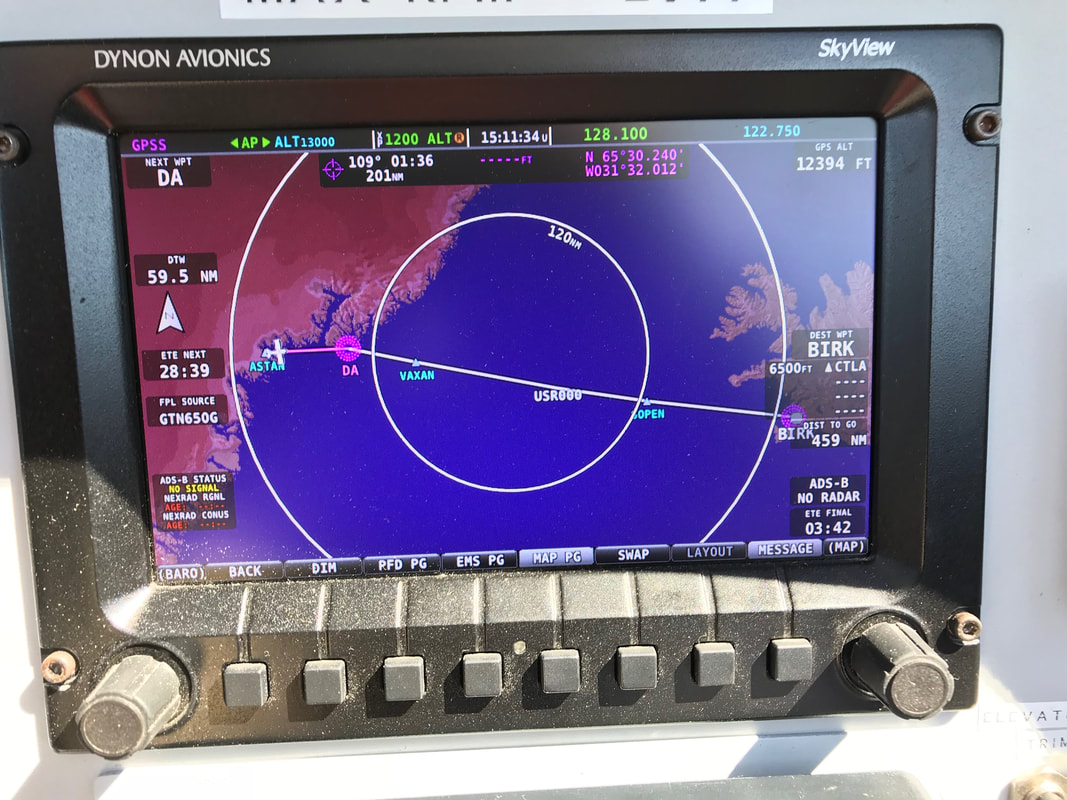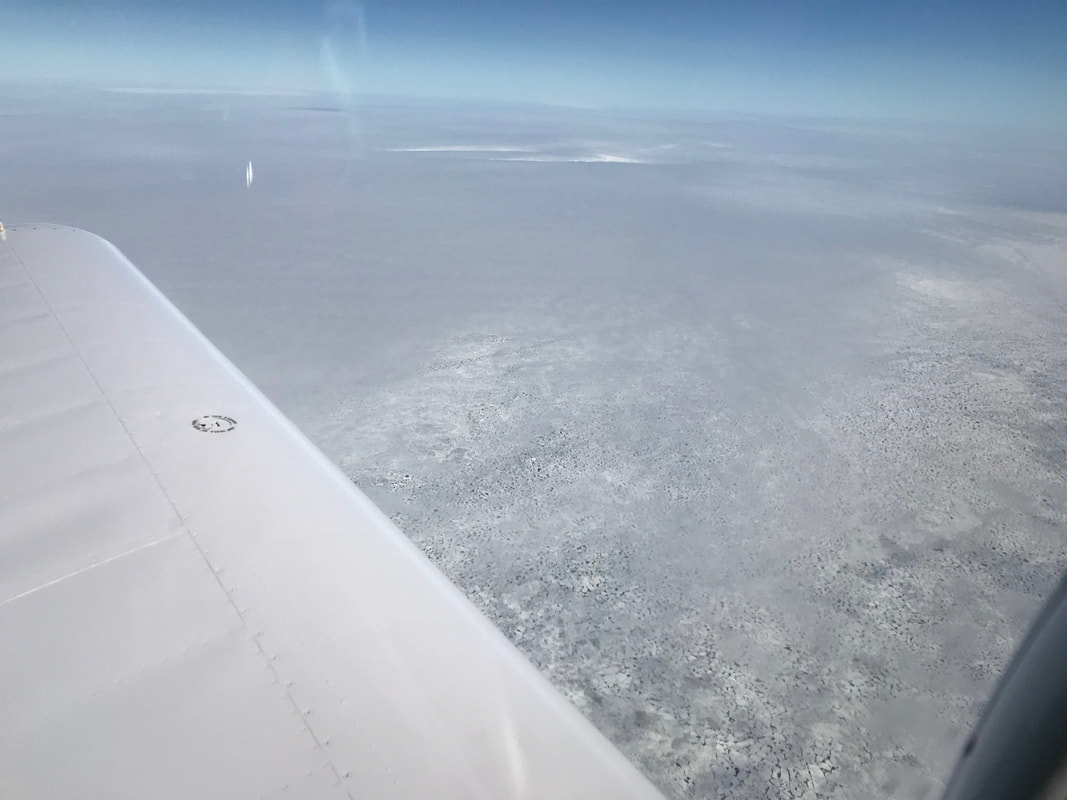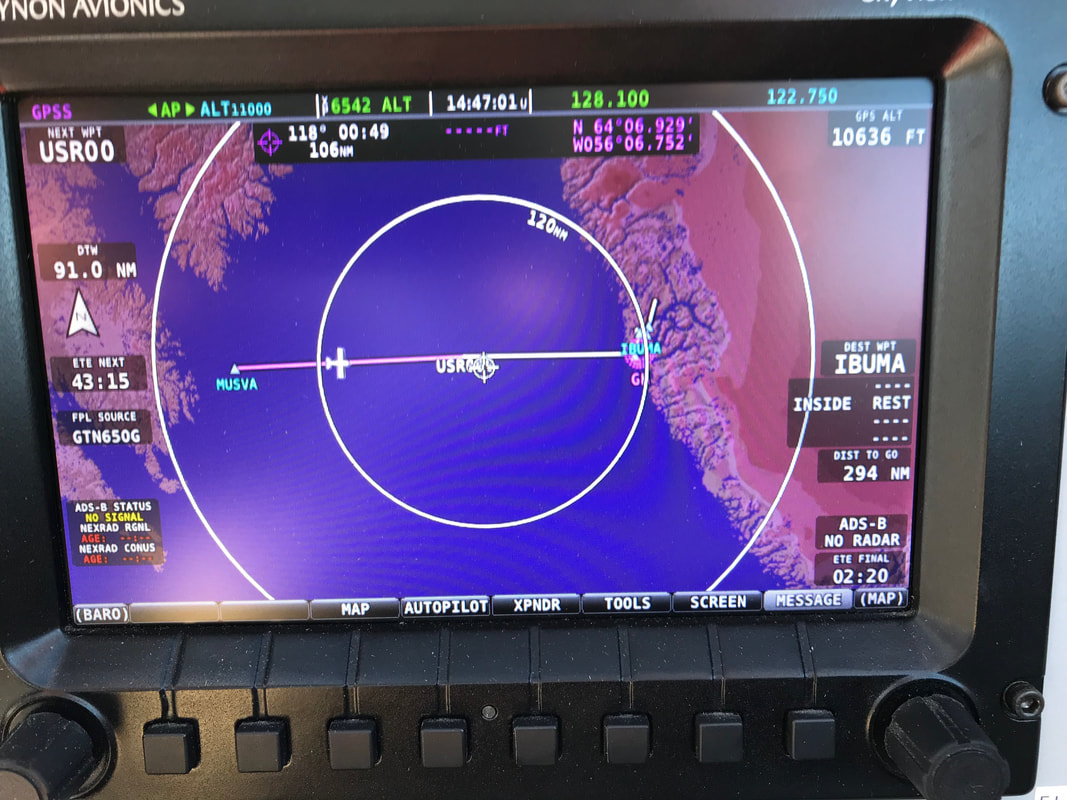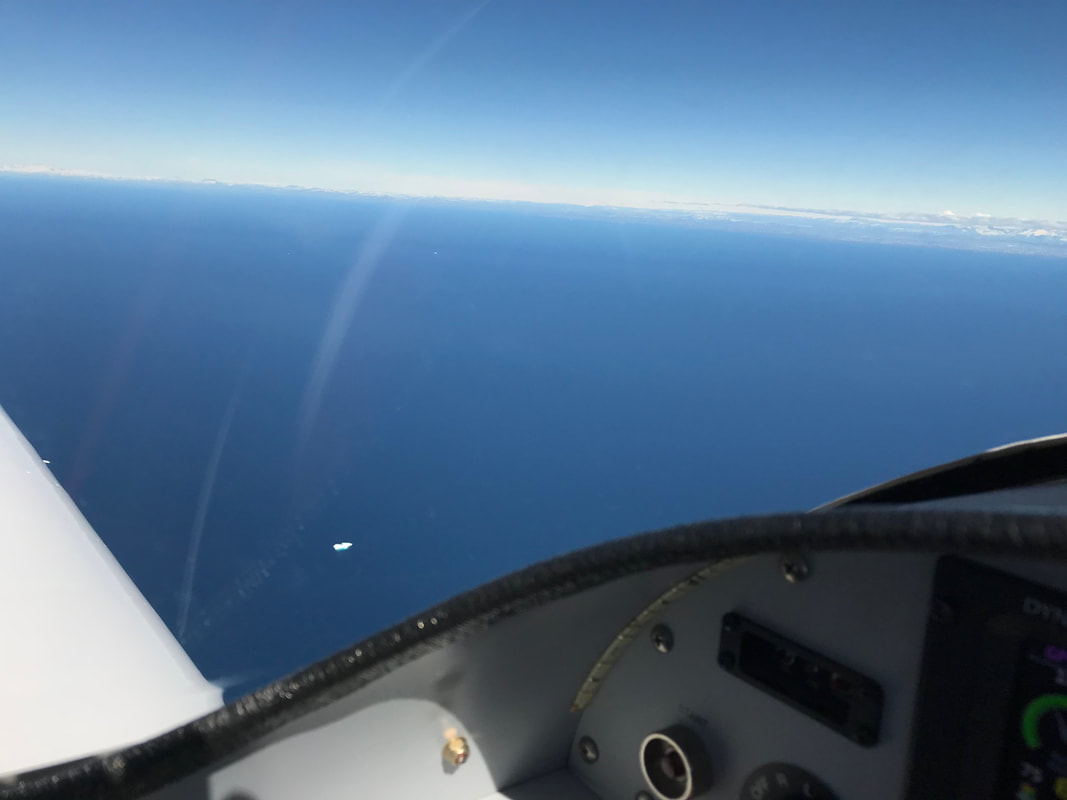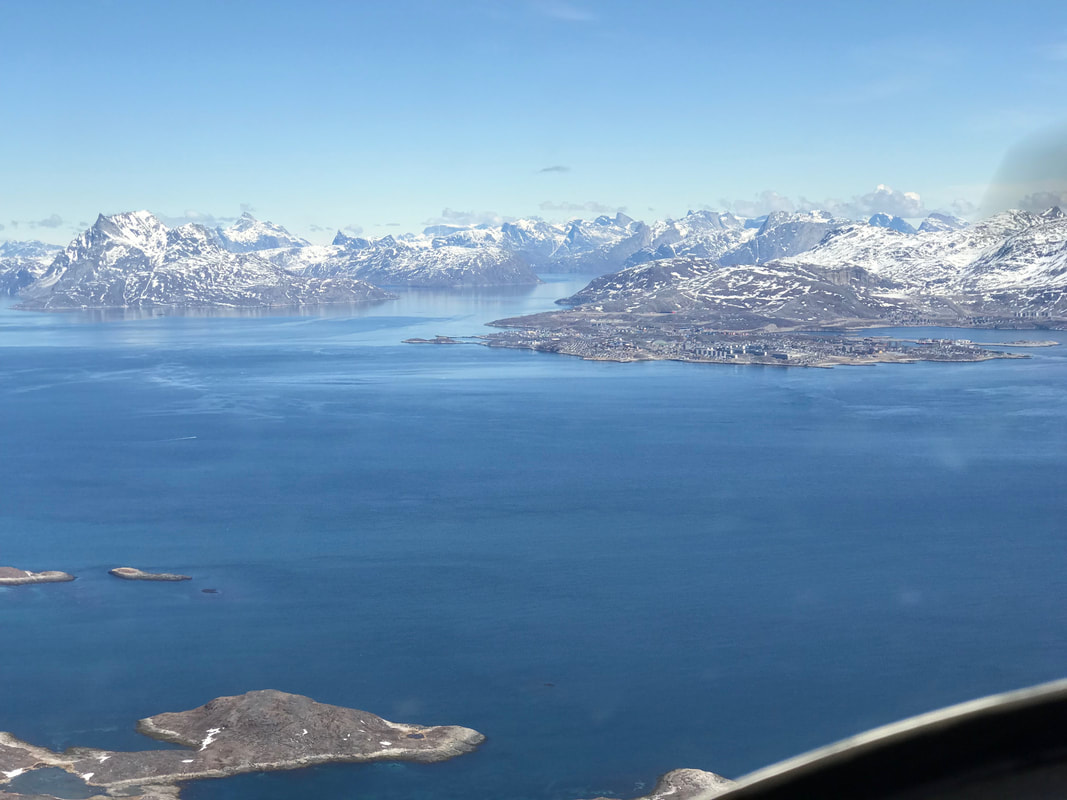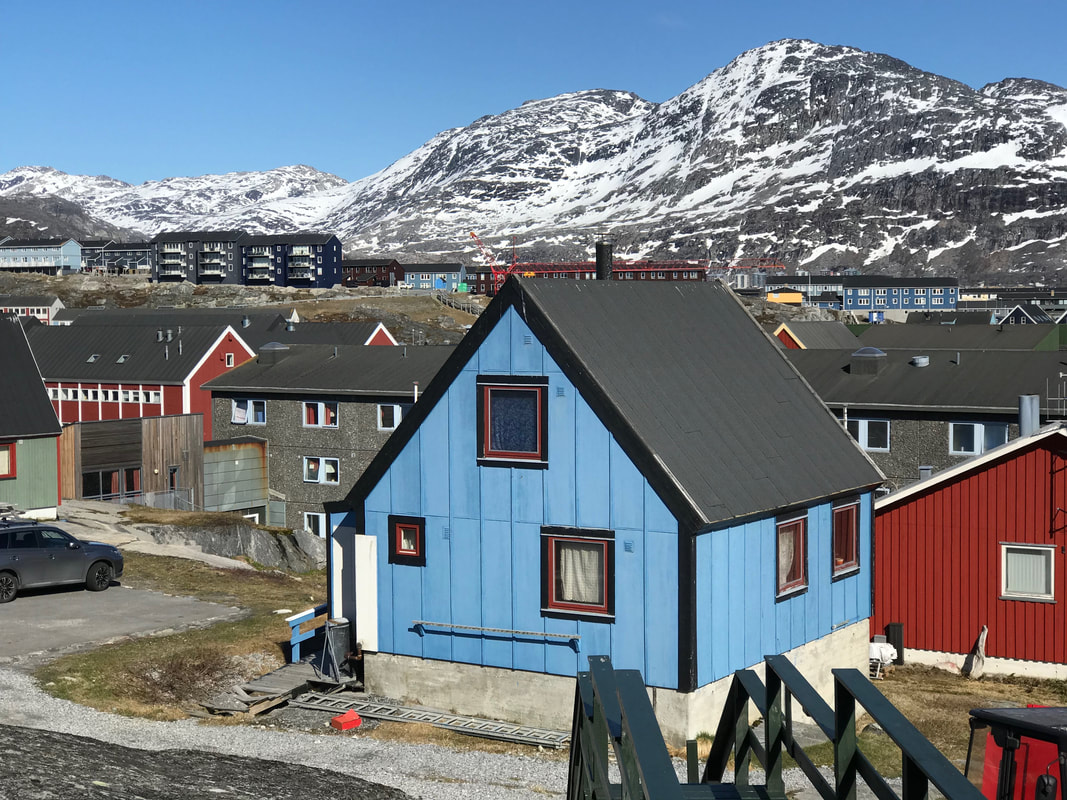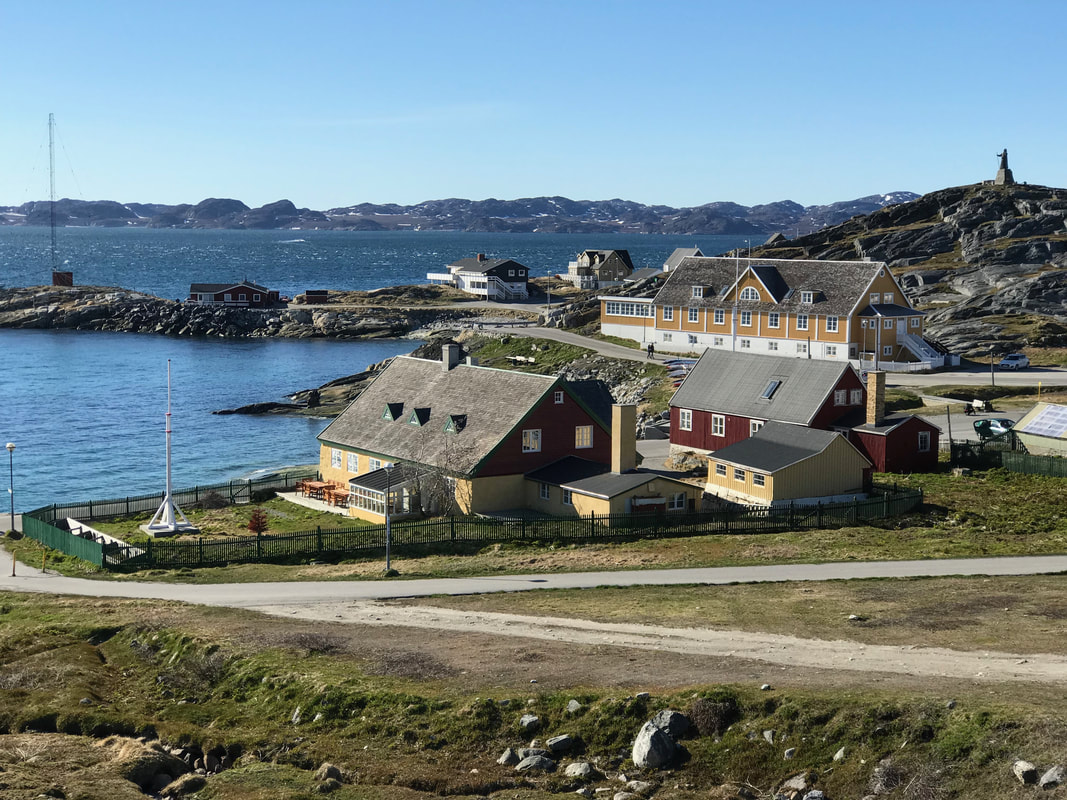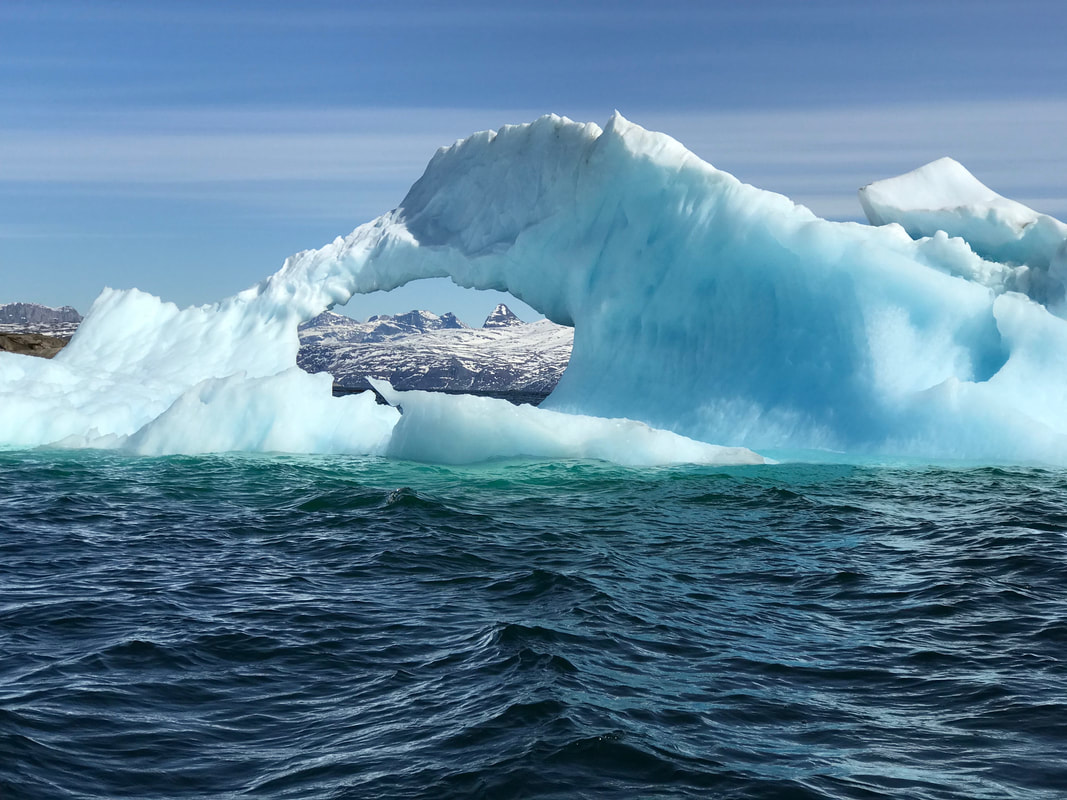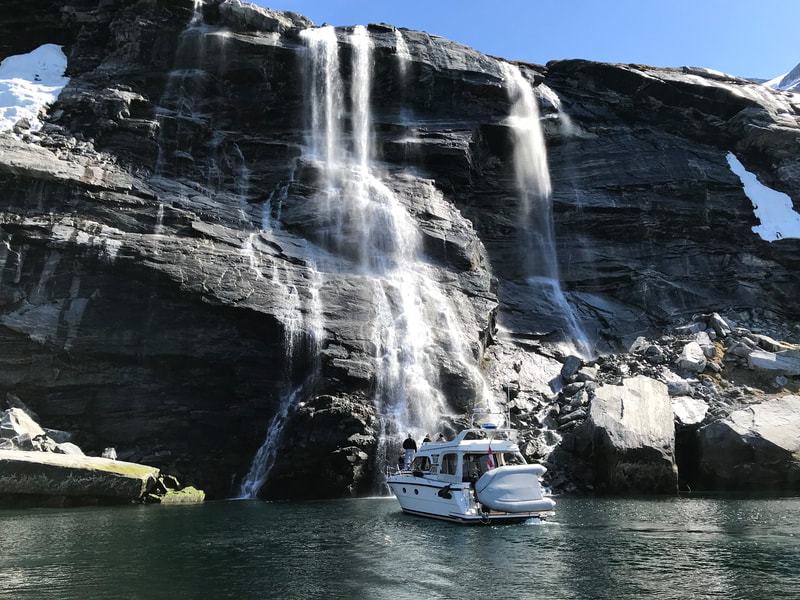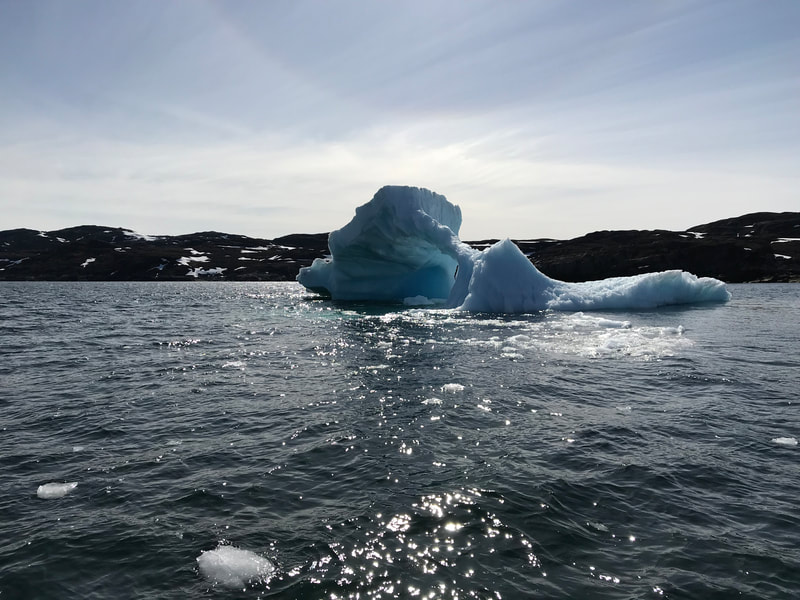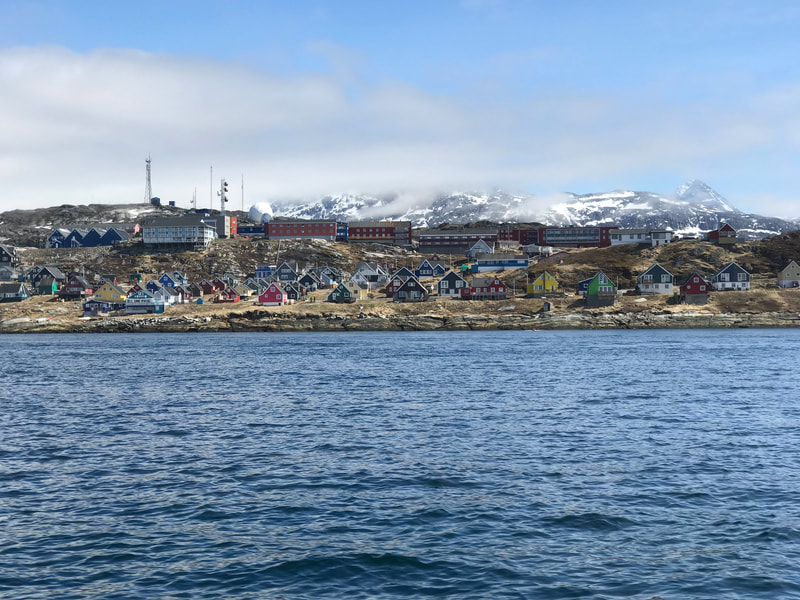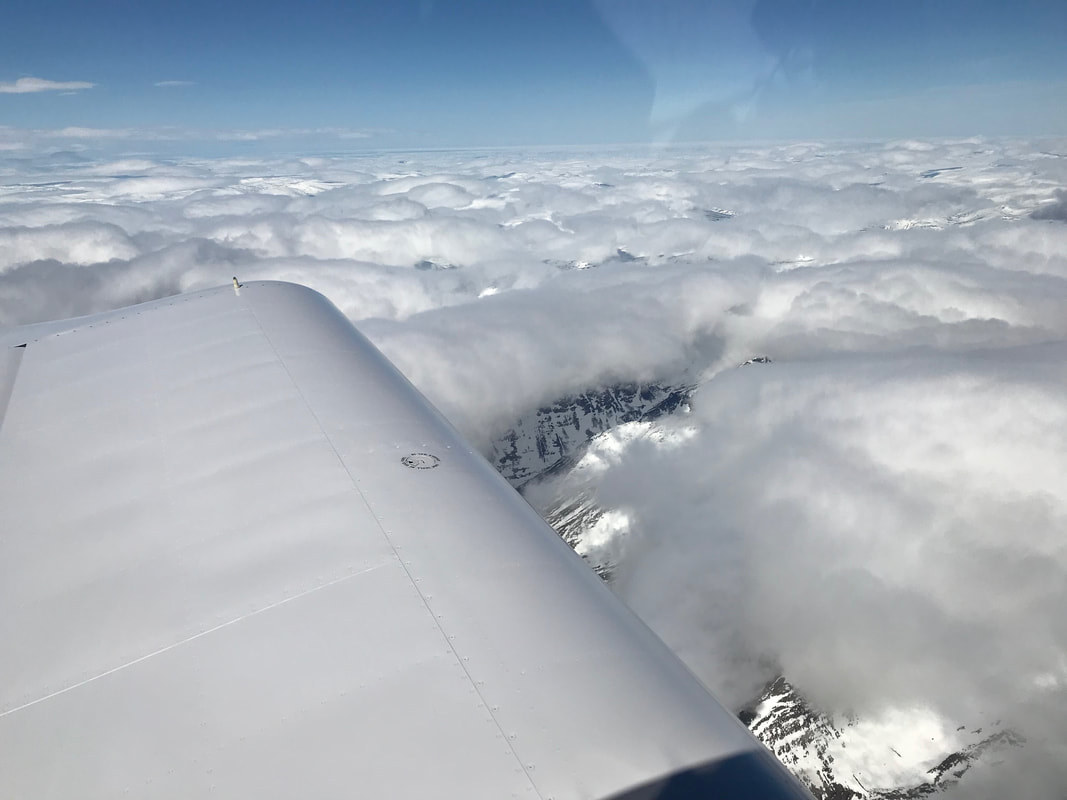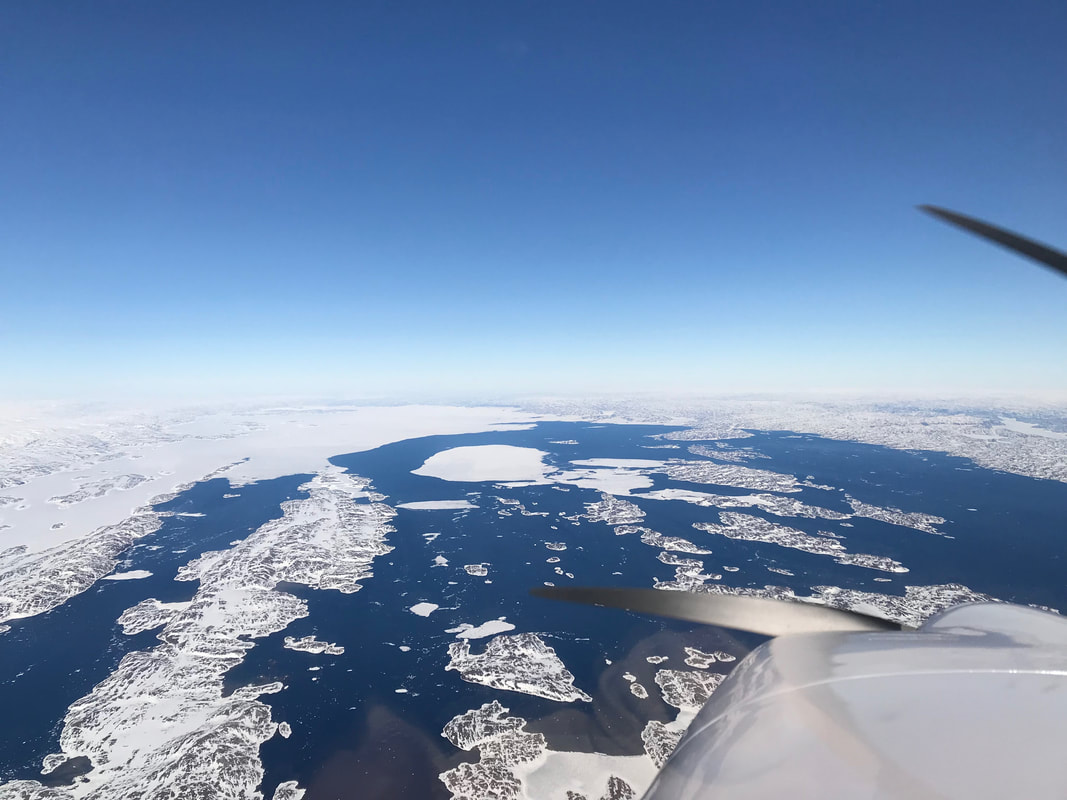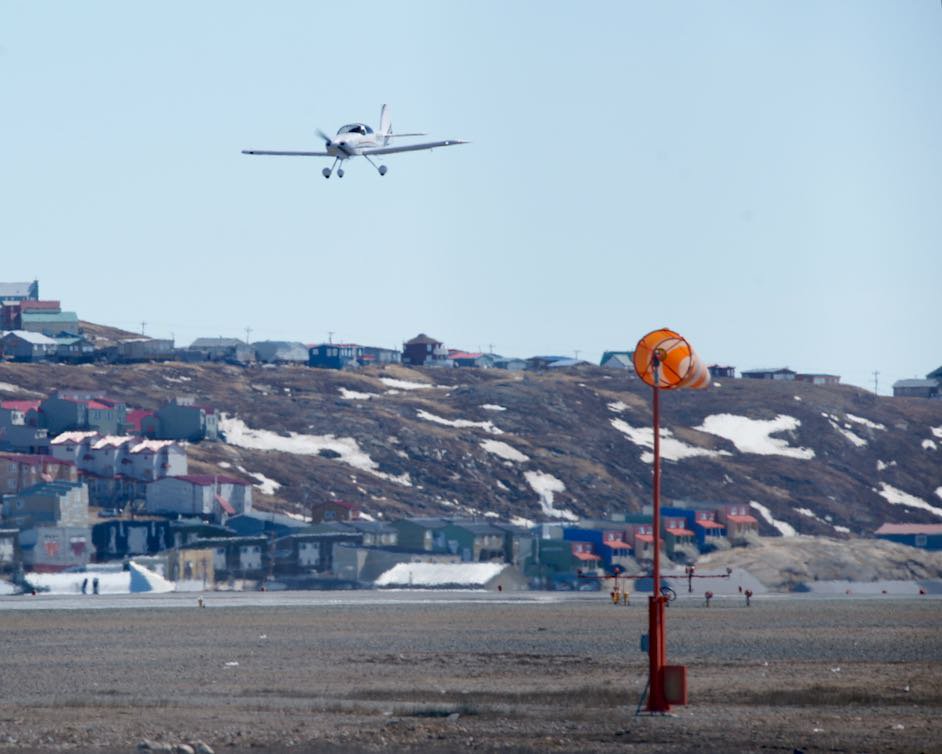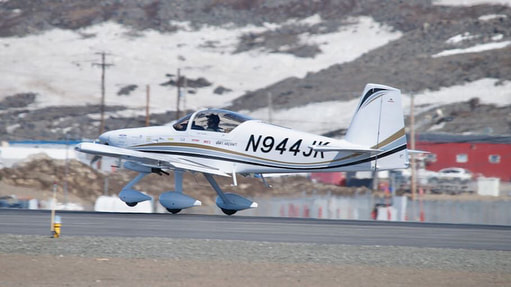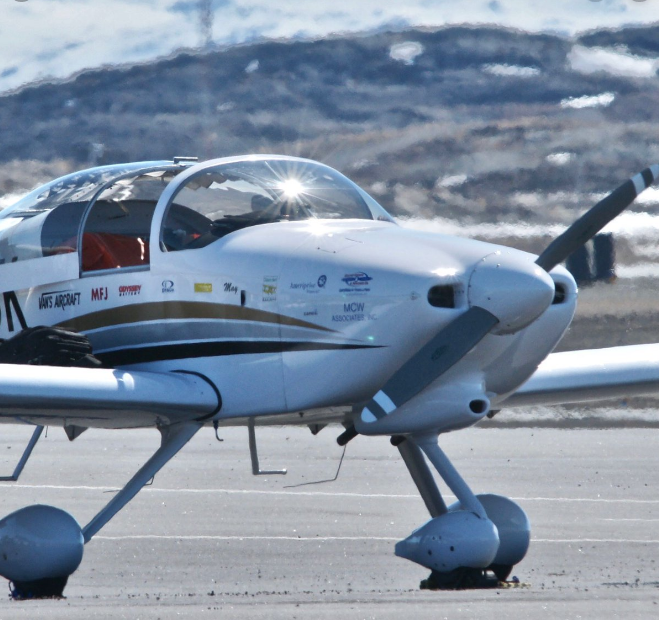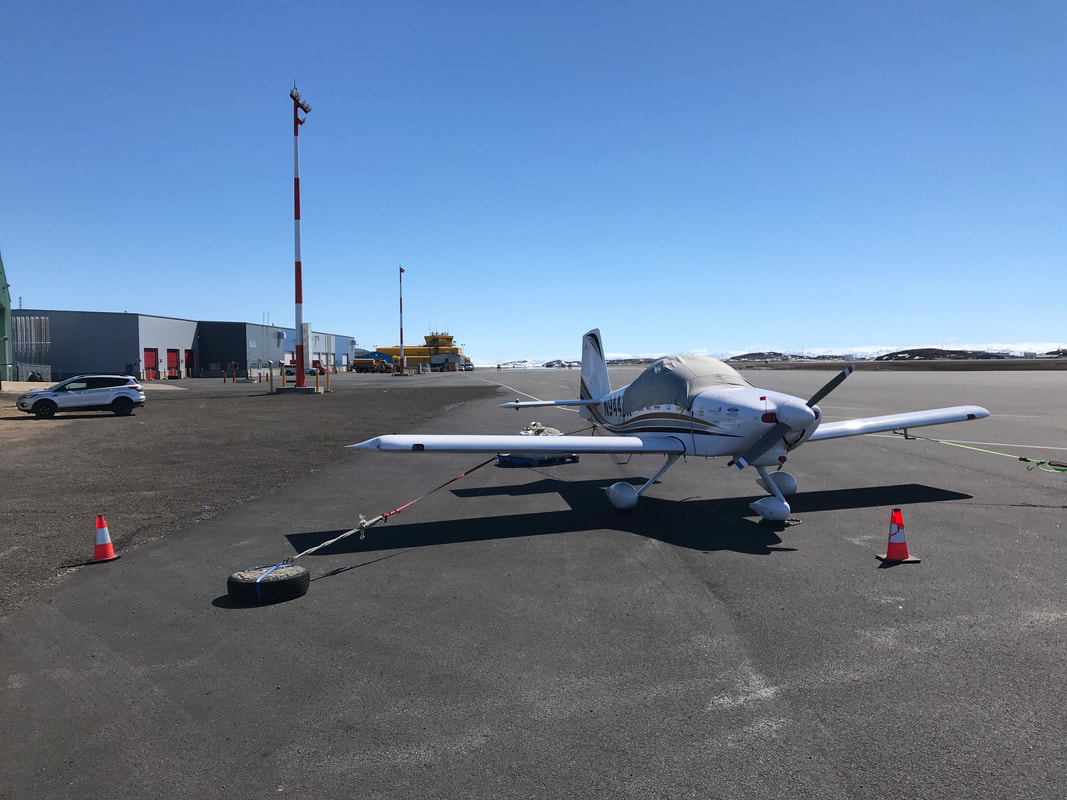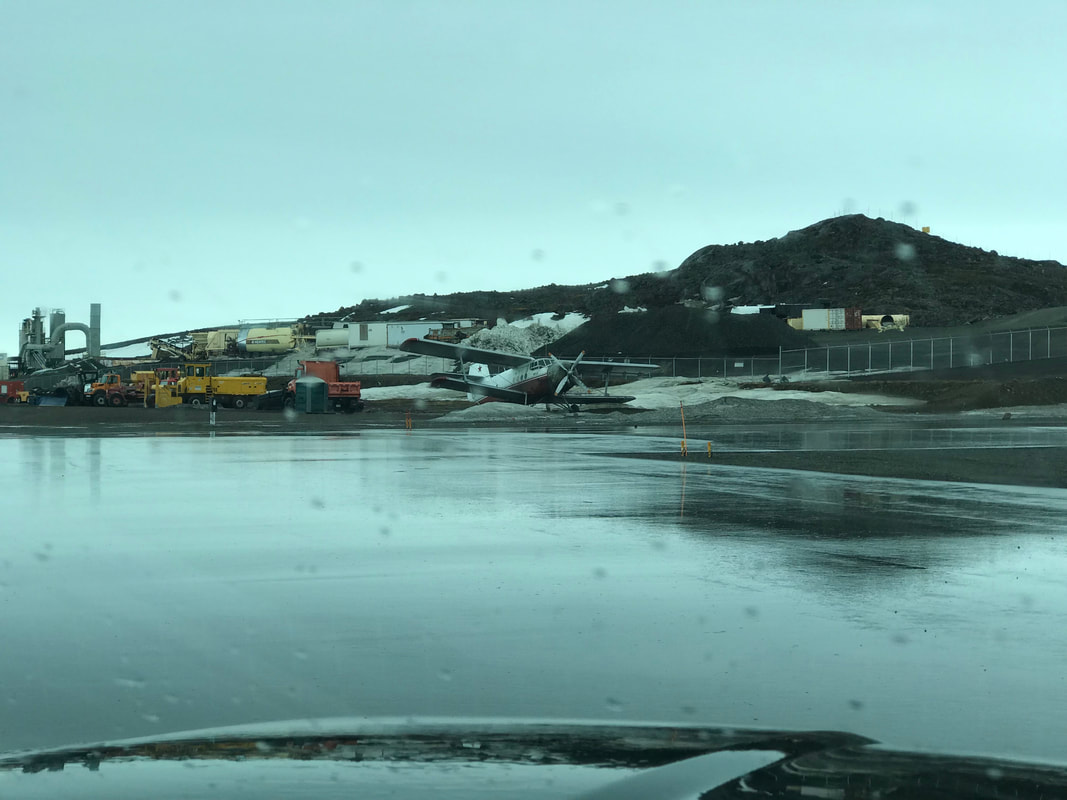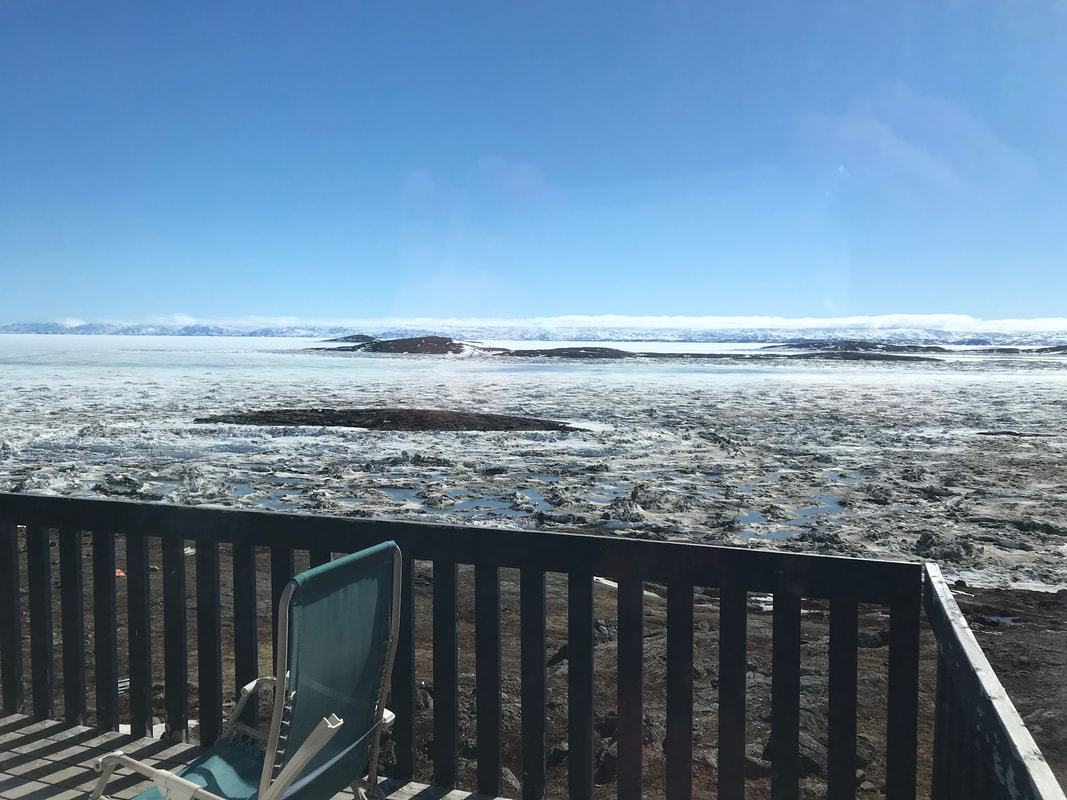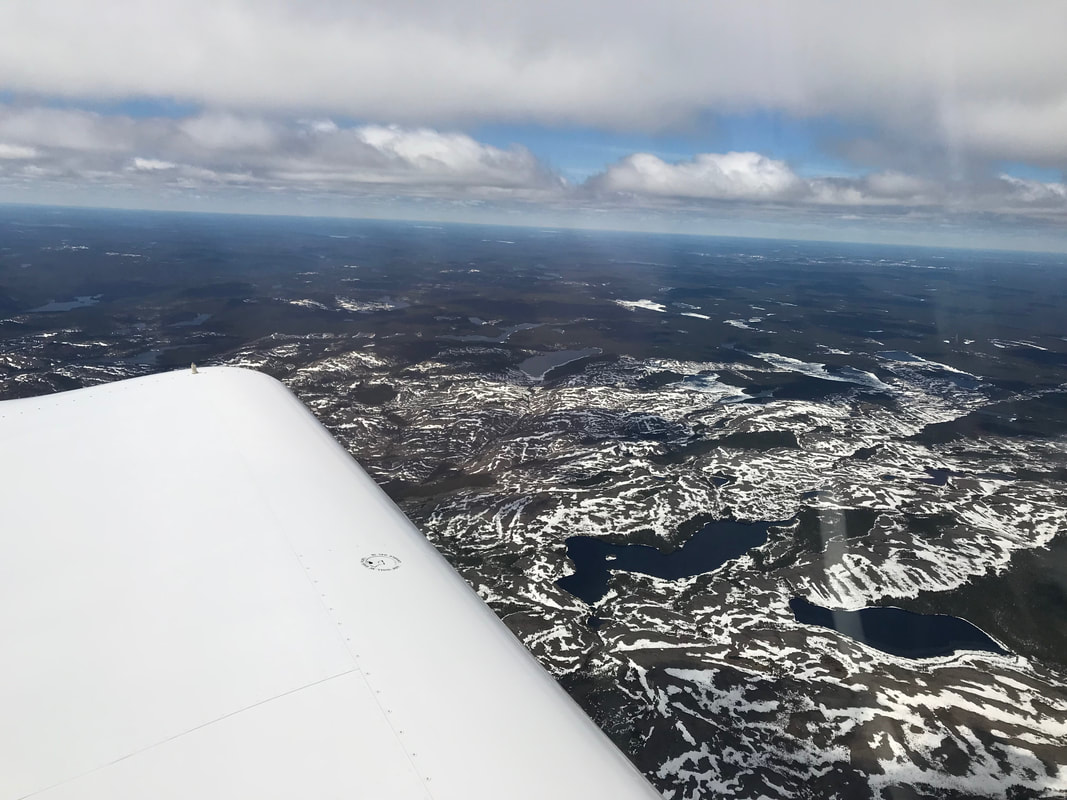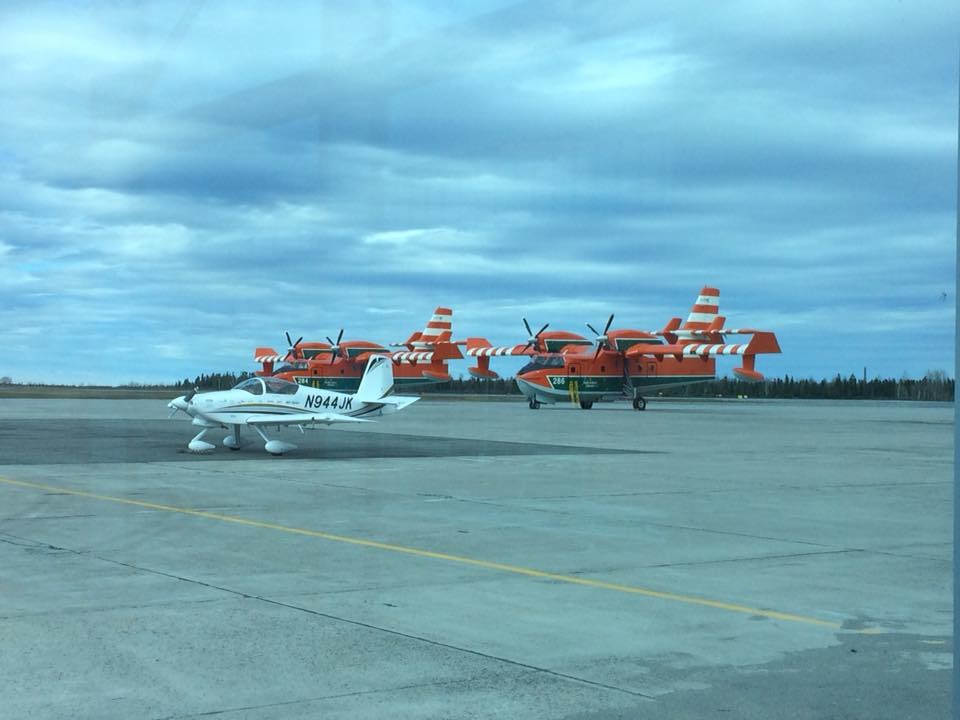|
Expedition Day 28 The route across Egypt, Suez canal, Sinai peninsula, and Jordan. Crossing over the Egyptian coast near Alexandria. Nearing Cairo, Egypt, air traffic control vectored me to about 25 miles east of the Great pyramids. From there I crossed the Suez Canal and climbed to 13,000 ft for terrain clearance over the Sinai peninsula. The late afternoon turbulence over the mountains of the peninsula made for a very uncomfortable ride. I was very excited to visit the middle east for the first time. I flew past biblical Mount Sinai, crossed over the Red Sea/Gulf of Aqaba, and landed at Aqaba International airport in Jordan. The entire international airport was opened for my sole arrival with hundreds of support staff. I felt overwhelmed with such a turnout. The next day I hired a driver, viewed Wadi Rum from a distance along the King's Highway, and explored Petra. Wild camels grazing along the King's Highway. Wadi Rum shimmering in the desert heat. The ancient city of Petra in Jordan, one of the 7 New Wonders of the World. The water channels show above were carved by the Nabataean people around 300 B.C. to collect every drop of moisture running off the canyon walls. My first glimpse of the mythical "Treasury" of Petra. I hiked for hours exploring the gorge, ruins, and the upper reaches of the site. One day was not sufficient to see everything. Tomorrow, I cross the entire Saudi desert from the Red Sea to the Gulf. No Indiana Jones inside the Treasury, but met some friendly camels outside. El Dier ("The Monastery"). The guy was furious that I took the picture without permission, the woman not so much. The interior of one of the Royal tombs carved out of Precambrian igneous rock and sandstone. The properties of the rock itself may have persuaded the Nabataeans to site their city here, as it was evidently suitable for rock carving and excavating.
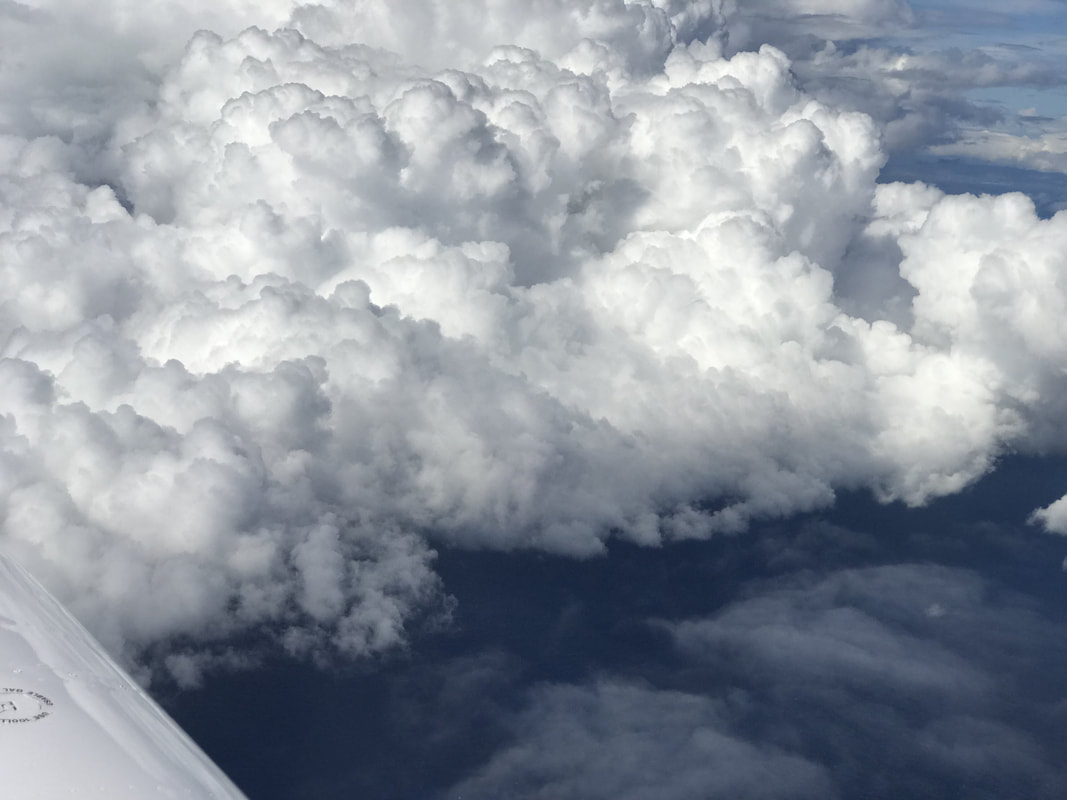 Expedition Day 27 The weather quickly deteriorated over the boot of Italy as I progressed further south towards Greece. I fought for improved vectors multiple times as ATC kept directing me in to cumulonimbus weather. Position reports were required every 10 minutes as there was no radar coverage off-shore. The dark waters of the Ionian sea are hidden from view as pass off the east coast of Italy. Not so much cloud dancing, but a mauling through cumulonimbus off the east coast of Italy. The RV-9A is very light and gets tossed around within the clouds. My standard operating procedure was to slow down to maneuvering speed to minimize stress on the airframe and pilot. I kept an eye on the g-meter to not exceed limits set by the RV-9A designer/engineer before the trip. Greek ATC placed me in to a 8 turn hold over the uninhabited island of Dia (Ntia).
On approach to Iraklion, air traffic control placed me in to a 8 turn hold at 1500 feet off the coast of Crete. After circling for 15 minutes over the island of Dia, I declared "running low on fuel", which was promptly ignored by ATC. Eventually, they vectored me to the ILS approach. My 75 knot stabilized approach speed was too slow for the following jet traffic. Heraklion tower badgered me to make all possible speed on final and landing. The airport needs an expansion, and is well known for long hold times for both arriving and departing traffic. I have never seen ground staff hustle so quickly to keep the flow of people and aircraft moving. After clearing customs, I was whisked to my hotel and greatly enjoyed an early dinner of Antikristo and rice, along with a local craft beer. I went for a walk, then prepared for the what would be the most interesting flight of the trip: fly 400nm over the eastern Mediterranean, the great pyramids, Suez canal, Mt. Sinai, and cross the Red Sea to Jordan. All in one day. Corrosion damage from a leaking 12v main battery. Italians to my rescue. During the first oil change and maintenance inspection of the trip in Italy, Luca Parazzolli (EAA, Chapter 1581) and I discovered corrosion damage to the high current electrical bus and associated components. This was quite unexpected, as the plane was in perfect electrical and mechanical condition before the start of my trip. The corrosion damage was caused by a leak of the primary 12V powersport battery mounted to the firewall and over the electrical components. The likely cause: 1) flight over the Arctic through extremely cold temperatures causing the battery case to crack. 2) a manufacturing error in the battery. The battery was brand new and installed just before the start of the trip. Luca networked with his fellow RV builders around northern Italy and obtained a new battery, main relay, starter relay, Silicone boot, and fabricated a new #2 battery cable, all within hours. We spent 15 hours repairing the electrical system to like-new condition and tested the engine and electrical system. Luca, you are my hero. Thank you for all of your help, resourcefulness, attention to detail, and great network of friends. The Spirit of Aviation lives on in Trento One of the many EAA chapters around the world. Members enthusiastically help out a RTW pilot in need. 1 million Euro view from Luca Parazzolli's hanger in Trento, Italy Smoke on! CREWRV8, Luca's aerobatic team practicing over Trento, Italy. (2) RV8, (1) RV9A experimental aircraft. Luca's hanger/workshop where we performed the oil change and emergency repairs on my aircraft. Photo credit: Luca Perazzolli A quick run-up, then departure from Trento, Italy through a narrow mountainous valley toward the Adriatic sea.
Photo credit: Luca Perazzolli
Expedition Day 24
This 735 nm leg would be the most complex I have ever flown. The flight would require transiting the air space of five countries with radio hand-offs to a dozen controllers.
Flying over the English channel at 10,000 feet. The coast of Belgium is visible at the top of the photo.
While crossing the English channel from England to Belgium, my thoughts were on the 1944 "D-day" invasion. My flight was a milk run in comparison with the 12,000 aircraft that participated in the invasion on June 6, 1944. By that time, the Luftwaffe was a shadow it's former self. Allied aircraft still encountered fierce AA. Historical note on another, earlier flight across the English channel: 90 years ago, Louis Bleriot, a French engineer, was the first to fly an airplane across the English Channel, 21 miles from Calais in France to Dover, England. The London Daily Mail had put up a £1,000 prize for the first airplane flight across the Channel.
Just outside Calais in Bleriot Place, which means Bleriot Beach, there's a small stone monument in a residential neighborhood commemorating the events of July 25, 1909. Near this spot, Bleriot made a short test flight in the dark at 4:15 am.
He was flying a tiny frail monoplane with a three cylinder Anzani motorcycle engine that had a tendency to explode if it overheated - or after about 30 minutes, whichever came first. The flight across the channel would take about 40 minutes. It was a calculated risk. Bleriot was not the only person trying to cross the channel in late July 1909. The Daily Mail, a London newspaper, had a put up a thousand pound prize to the first person who could do it. To be official, the flight had to happen in daylight, and at 4:41 when the sun was officially over the horizon, Bleriot took off. He had no instruments. The weather was blustery and misty. Visibility was not good. A French destroyer was positioned half way across the channel to help guide him, but legend as it - he got lost. Bleriot cut his engine and came to Earth pretty hard, breaking his propeller and landing gear, and proving again that any landing you can walk away from is a good one.The bad weather worked to his advantage, though. A rain shower cooled his engine. He had his way to the English coast, spotted someone waving a flag to signal the landing spot near Dover Castle. Bleriot cut his engine and came to Earth pretty hard, breaking his propeller and landing gear, and proving again that any landing you can walk away from is a good one. Today the open grassy field where Bleriot landed is overgrown with dense shrubs. But as you walk through the thicket, suddenly you find yourself in a wonderful clearing, and you can stand where history happened. The outline of his plane has been set down and memorialized in marble. Like many small airplanes that made history, you are surprised at how small it is. Bleriot won the prize money and became the next great aviator to become world famous in an instant, but those were the days when flying records were made and broken quickly. Another article describing his flight. CREDIT: DAN PATTERSON, WYSO.org, Smithsonian
At 14,000 ft over Switzerland, the plane accumulated some light Ice fairly quickly on the wing and tail surfaces. I began my descent to warmer temperatures as soon as practical over Italian airspace.
Expedition Day 22 After a brief overnight stay in Wick, Scotland, I flew south over Aberdeen, the North Sea, North York Moors National Park, and a patchwork of green farmer's fields to Cambridge. I was amazed at the vibrant plane spotting community in Duxford. David Whitworth took my photo as I unpacked my aircraft. Photo Credit: David Whitworth, Duxford Diary. By incredible coincidence, G-GDRV was parked on the ramp next to N944JK. This aircraft was flown around the world by Manuel Queiroz in 2006. While preparing for my RTW trip, I read about this globe circling aircraft in his book "Chasing the Morning Sun" (www.chasingthemorningsun.com). During weekends, IWM offers flights in the Spitfire and Dragon Rapide aircraft. The English are proud of their aviation history and support the IWM. A V12 powered Spitfire tearing up the sky above Duxford. The beauty of a Spitfire. One of the many resident Spitfires at the Imperial War Museum in Duxford, England. IMF Duxford hosts an extensive collection of aircraft in multiple museums spread over the grounds of a former WWII fighter base. I wandered the museums for hours, chatted with the mechanics working on the war birds, and hung out with the spitfire crew giving rides to the public. What a fantastic day off while surrounded in aviation history. Thank you Allan, Peter, and Chris for the VIP pass, transportation, and assistance during my stay at IWM, Duxford. Allan went the extra mile to help me plan my flight across the complex European air space from England to Italy. The SR-71 "Blackbird" demanding attention at the American museum at Duxford. Flying at Mach 3.2 at 80.000 ft, the nose would warp from the 800F surface temperature, requiring a periodic ironing-out process.
Expedition Day 21 After an extremely cold and stressful crossing of the North Atlantic from Nuuk, Greenland to Iceland, I made a beeline to Iceland's famous “Blue Lagoon". I soaked for hours in 102F (39C) mineral rich seawater, which is a byproduct from the nearby geothermal power plant. My original route of flight from Reykjavik, Iceland to Wick, Scotland. The route was modified prior to takeoff to fly at 3000 ft and below freezing levels off the coast of Iceland. I departed Reykjavik in light rain, and flew south-east for 100 miles before clearing the clouds and climbing higher for better winds. A huge storm moving quickly across the North Atlantic towards Iceland potentially would keep me grounded for the next five days. My plan was to leave Reykjavik in the early morning just before the storm hit. A large "High" pressure area parked over the west coast of Ireland provided clockwise wind rotation and 36 knot tail winds towards Scotland. 173 knots ground speed at 6.2 gph. I was thrilled with the 36 knot tail wind. Passing the rugged Faroe Islands enroute to Scotland. EGPC - ATC reported winds at 29 knots gusting to 38 knots right down the runway. Wick is located at the northern tip of Scotland and gets blasted by unrelenting arctic winds. The landing at Wick, Scotland was like riding a bucking bronco down to the ground. After touch down and half stick back to protect the nose wheel, the plane started to climb again. I hope Wick ATC would not charge me for multiple landings! The taxi to the “Far North Aviation” hanger was practically uncontrollable in the high surface winds. To escape the blustery winds outside, I taxied my plane in to one of the WWII-era hangers at Wick airport. The floor of the hanger was coated in a slippery layer of grease, from hundreds of oil changes done on WWII bomber and fighter aircraft.
For many ferry pilots, Wick is the last stop in Europe before heading to Iceland and onward to North America. The entire airport is a time capsule from the 1940's and has a wonderful vibe. Historical note from WWII: On 21 May 1941, a photographic reconnaissance Supermarine Spitfire piloted by Flying Officer Michael F. Suckling took off from Wick, and flew to Norway, in search of the German battleship Bismarck. If Bismarck was to break out into the North Atlantic, she would present a significant risk to the ships supplying Britain. 320 miles to the east of Wick, F/O Suckling found and photographed her, hiding in Grimstadfjord.[3] This information enabled the Royal Navy to order HMS Hood and other ships, as well as aircraft, to take positions intended to track Bismarck, and prevent her from entering the North Atlantic. In ensuing battles, Hood was sunk, and, later, Bismarck. German battleships and battle cruisers never again entered the North Atlantic. Credit: Wikipedia, Wick Airport. Expedition Day 18 After three relaxing days in Nuuk, it was time to depart Greenland. My flight was scheduled to climb to 13,000 ft over the ice cap and head east towards Iceland. Outside air temperatures decreased to -15c as I progressed over the east coast of Greenland. It was impossible to keep warm, even with the heater on full blast. Beneath my plane lay clouds at 11,000 ft and the two mile thick layer of ice called the Greenland Ice cap. My view was largely blocked due to the cloud layer. On a clear day, previous RTW pilots have spotted dozens of polar bears wandering across the massive ice cap. IMAX worthy Thousands of icebergs were visible while I flew over the coastal waters of eastern Greenland. The 11,500 ft (3505 m) underwater cataract is located in the Denmark Strait. Enduring the Denmark Strait.
I was increasingly concerned about hypothermia. My body temperature was dropping despite the thick neoprene survival suit and down jack I was wearing. The cabin heater was on full blast and the shivering persisted for the entire flight. I requested a descent to a lower altitude with somewhat warmer temperatures and greater oxygen levels for the passage over the 450nm Denmark Strait. As I approached the north-west coast of Iceland, the cloud layers kept building to over 11,000 ft. ATC reported the ice level at 5,000 ft, so I again climbed to remain near the top of the cloud layers until close to the airport terminal area. Just off the coast, I descended quickly through the cloud layers as ice coated the leading edges of the wings. In less than 60 seconds, the windshield was iced over, obscuring all forward visibility. Ground temperatures were above freezing, so I continued my descent following vectors from ATC. Below 3,500 feet, the ice melted and quickly shed off the airframe. Airports throughout Iceland reported similar conditions, so landing at Reykjavik seemed the best option with it's precision approach and long runway. I landed at Reykjavik airport (BIRK) chilled to the bone and relieved to be on ground. Expedition Day 16 The frozen North Atlantic from 11,000 ft over the Davis Strait in mid-summer. I selected this altitude because it was thousands of feet above the uniform cloud layer containing freezing fog and known rime icing conditions. No visible moisture was present at my flight level with temperatures about -6 C. My ISPLR single man life raft and ditch bag were close at hand in the event of an emergency. 80 percent of the time, the cold, scary Atlantic was hidden from view, with an occasional glimpse of the ice pack between gaps in the clouds. Eventually, the clouds dissipated and the ice sheet melted about half way across the Davis Strait. On the horizon, a white line of jagged mountains, then Fjords grew in size as I approached the west coast of Greenland. The coastal capital of Nuuk was invisible until I could spot the bright, primary colored houses scattered around the harbor. 446 nm from Iqaluit to Nuuk with 25 knot headwinds. The EFIS MAP displays the route and geography on both sides of the crossing with no ADSB or radar coverage. I am getting better at blindly broadcasting position reports every 5 minutes. I spotted my first Iceberg 100 nm from Greenland. It was likely big enough to sink the Titanic. The incredibly scenic approach to Nuuk, Greenland. The airport is perched on a bluff above the city and a beautiful harbor. The houses and even the aircraft at the airport are all painted in bright colors. Colorful houses in contrast to the stark landscape. There are only 55,000 people in the entire country. On a layover day in Nuuk, the owners of my guest house asked me to join them for their first coastal cruise of the season. Besides lunch, we packed a huge caliber rifle in the event of an unexpected polar bear encounter. The bears were apparently quite hungry and show no fear at this time of year. I had a wonderful time with my hosts as we explored the Greenland west coast, cascading waterfalls, and dodging miniature icebergs called growlers.
Expedition Day 12 On June 12, I filed IFR and flew along the east coast of Labrador at 11,000 ft, avoiding rain/snow clouds to the west. The terrain is still covered with snow and ice with few alternative airports along the way. It was surreal to cross over the frozen North Atlantic ocean en-route to Baffin island and Iqaluit. The cabin heater and my flight suit barely could keep me warm with outside air temperatures hovering at -5 C. The ground was obscured under the clouds most of the way, but occasionally I could see a glimpse of the land. It was a real pleasure to travel at up to 160 knots at 6.5 gph with 25 knot tail winds. Instrument Landing System (ILS) approach in to Iqaluit, Nunavut. The mighty RV-9A landing in to a brisk wind. Photo Credit: Twitter (thank you airplane spotter living in Iqaluit!) 63°44'49.09"N, 68°31'2.17"W and the closest I have flown to the North pole. Photo Credit: Twitter After landing, I fueled the plane with the last of the 2017 AVGAS (2 barrels remaining) . Frobisher bay was still frozen and had not received it's one shipment of fuel for the year. I lost a few gallons fueling the plane in 30 knot winds. A broken down Antonov AN-2 is pushed to the side of the runway. Behind the battered aircraft, a chain-link fence keeps out wandering and curious polar bears. The weather this far north is extremely unpredictable and one can experience all seasons within a short period of time. The temperature hovered around 1C while I waited 3 days for a weather opening to Greenland. The frozen Frobisher Bay is close to break-up and the entire town is waiting for the supply ships to arrive.
Expedition Day 11 The permit to enter Greenland was finally approved, so I decided to continue to Bangor, Maine. I was fortunate to meet up with David, a RV-12 owner and member of VAF in the Bangor area. He seems to know many of the RV owners on the east coast and very involved with the community. The next day, I flew from Bangor, Maine over the St. Lawrence river and rugged terrain to Goose Bay, Newfoundland and Labrador, fighting head winds all the way. I was glad to have the aft ferry tank filled to capacity before departure. The range of the aircraft without the 66g Turtle Pac is 1250nm. There are not many alternative airports in this remote area. Water bombers ready for the fire fighting season. It snowed a few nights ago. Will summer ever arrive this year?
Goose Bay is an unexpectedly large airport with lots of turbo prop and jet traffic. A passenger from one of the inbound flights spotted "May" in the terminal area , Googled my tail number, and handed me a donation towards the "Alzheimer's Association of America". Thank you Rob Perry! Please make a donation towards the Alzheimer's Association. |
Archives
September 2018
Categories |
